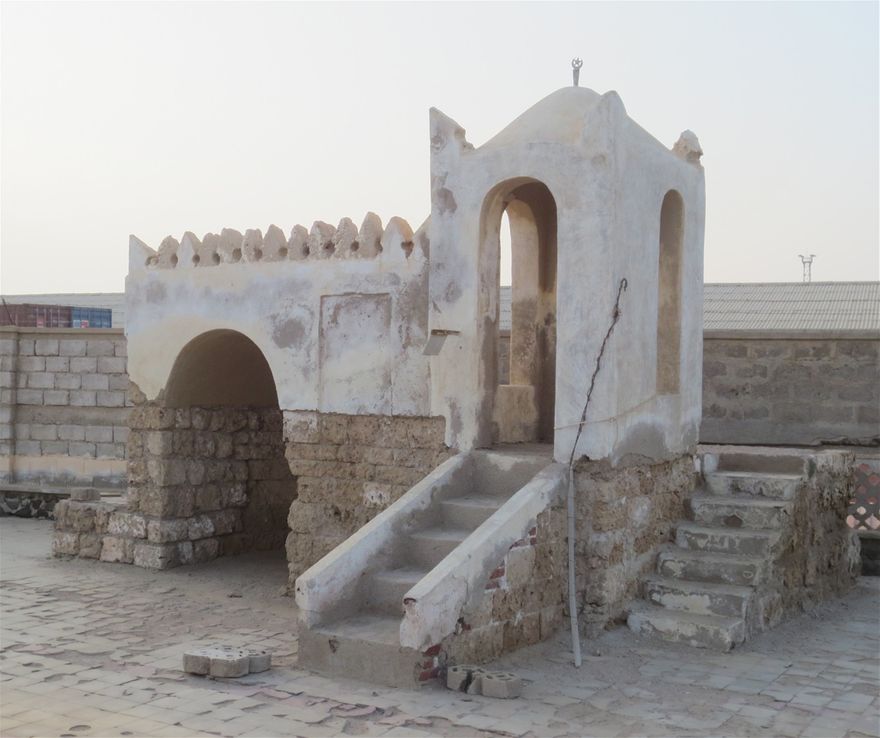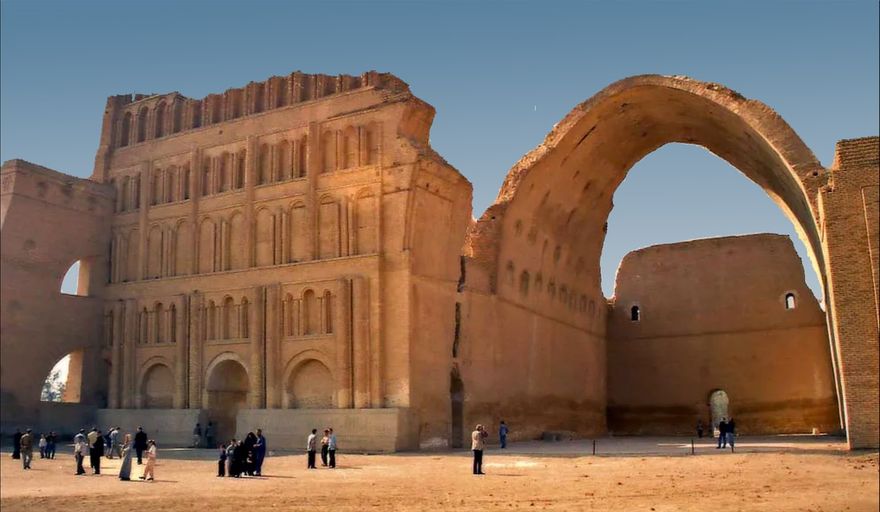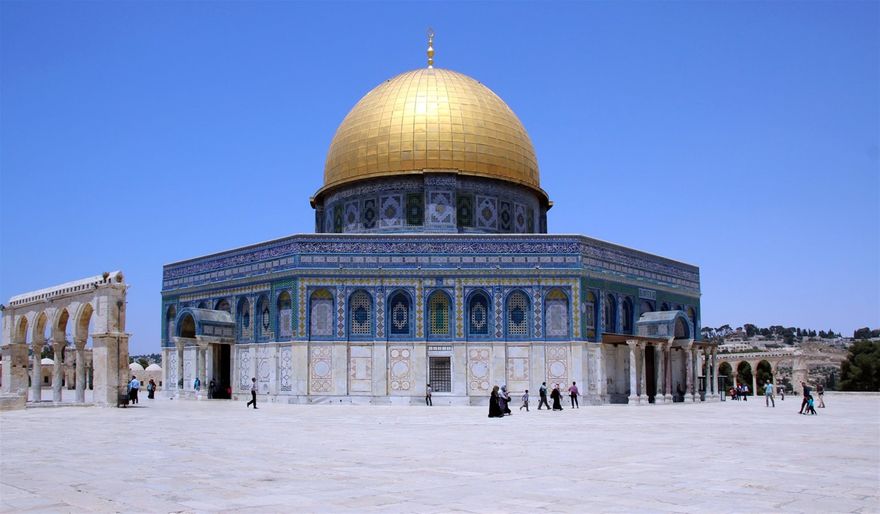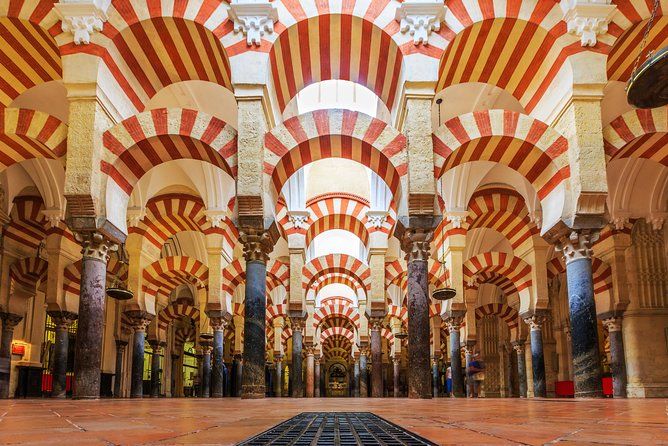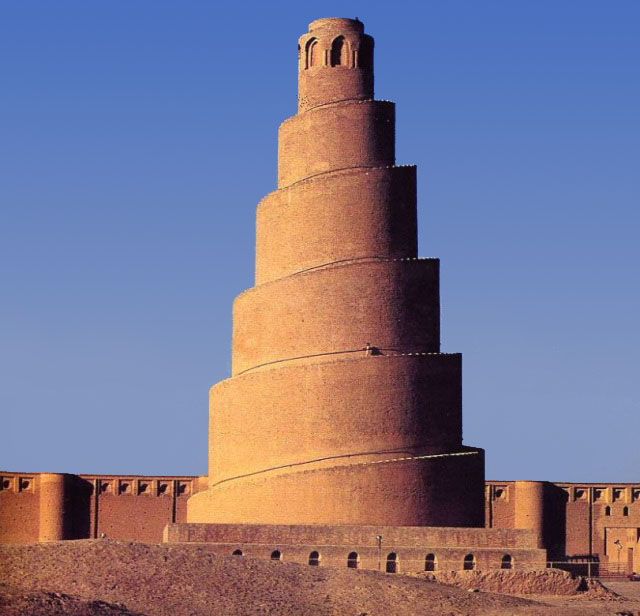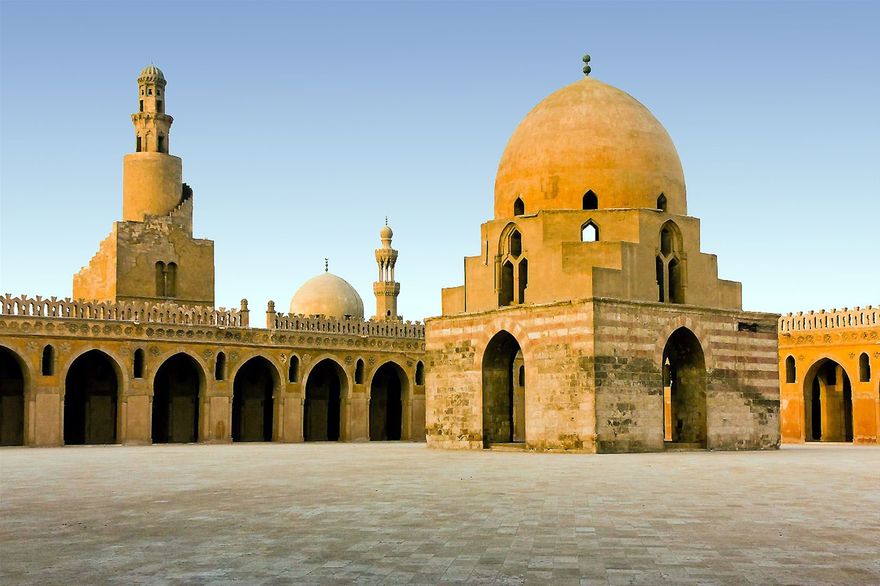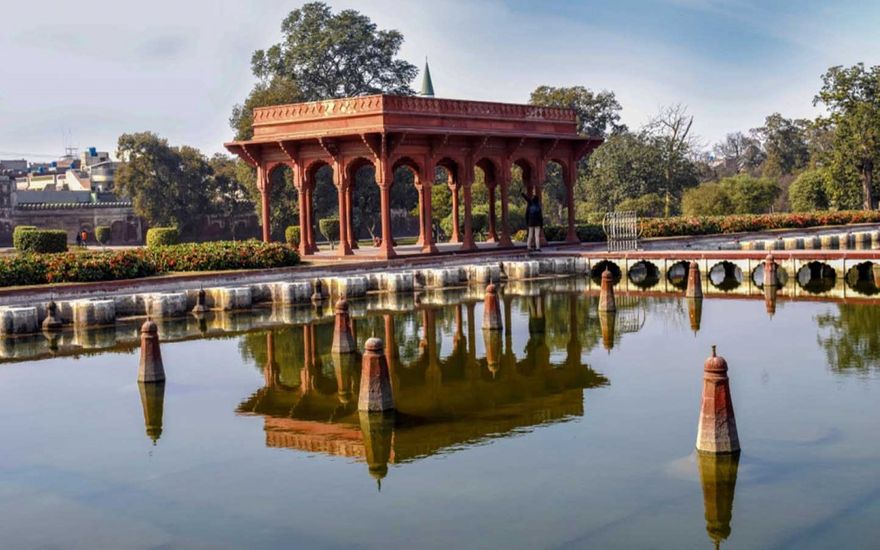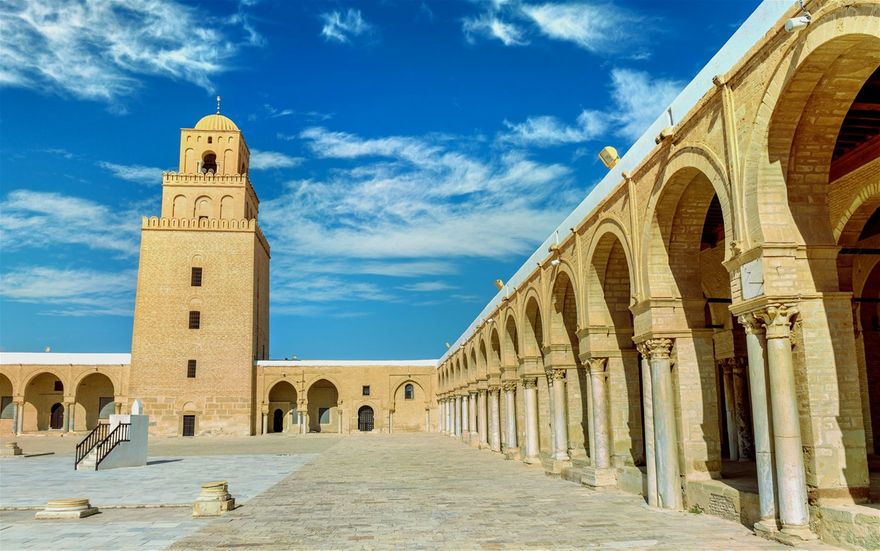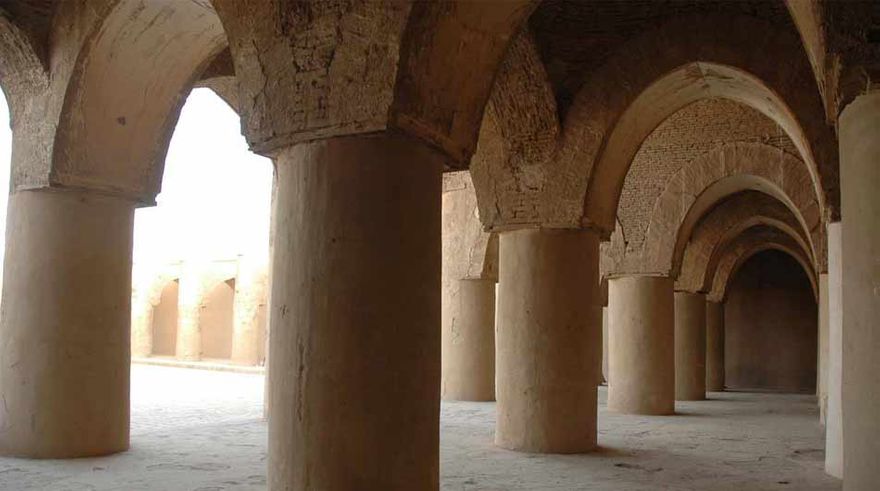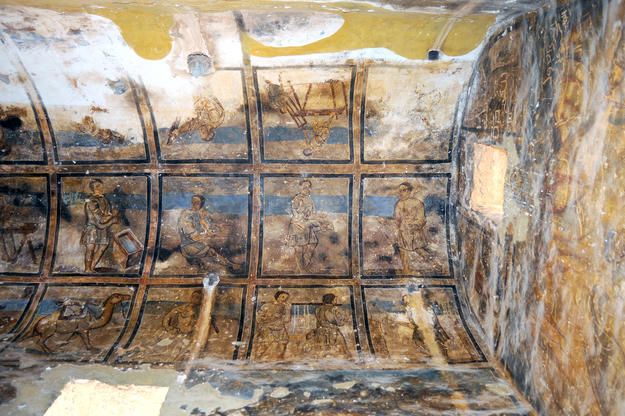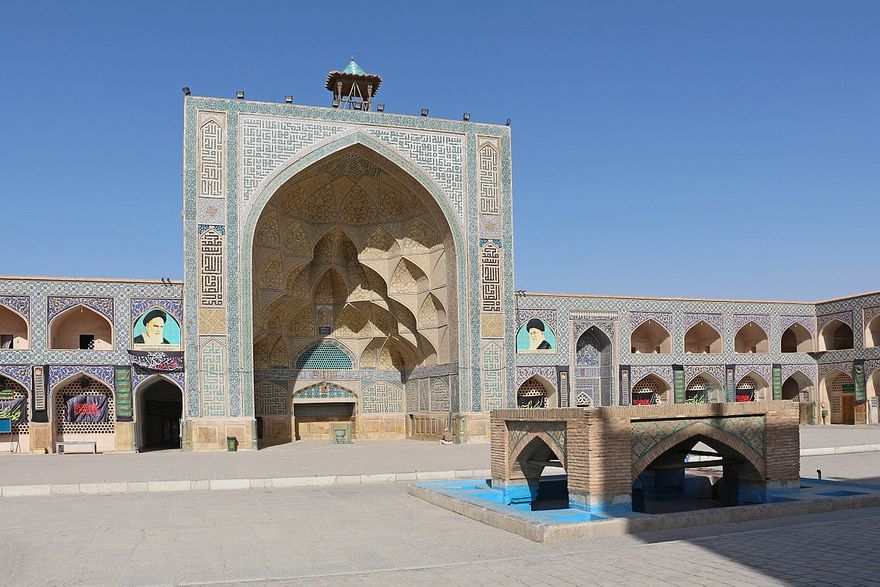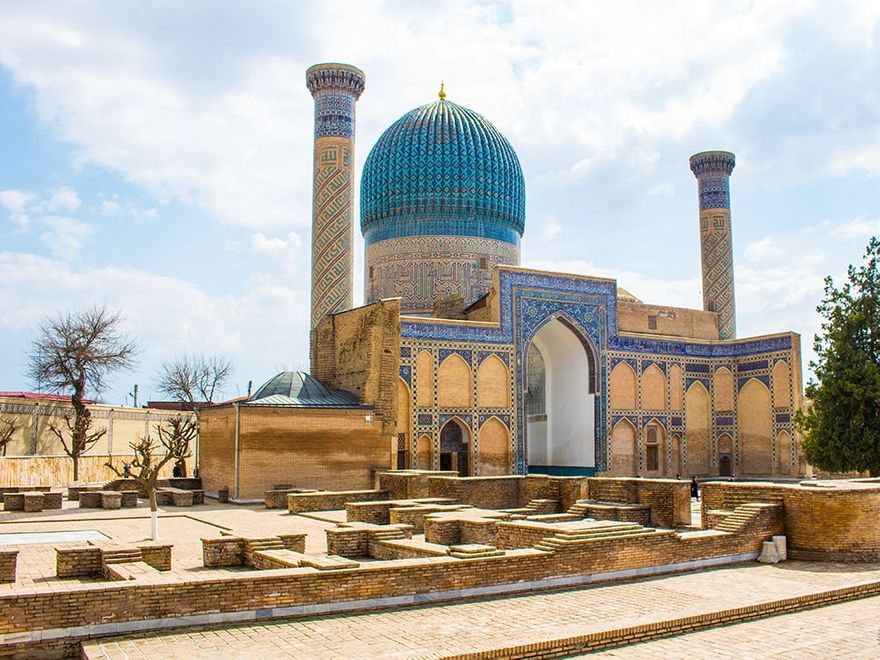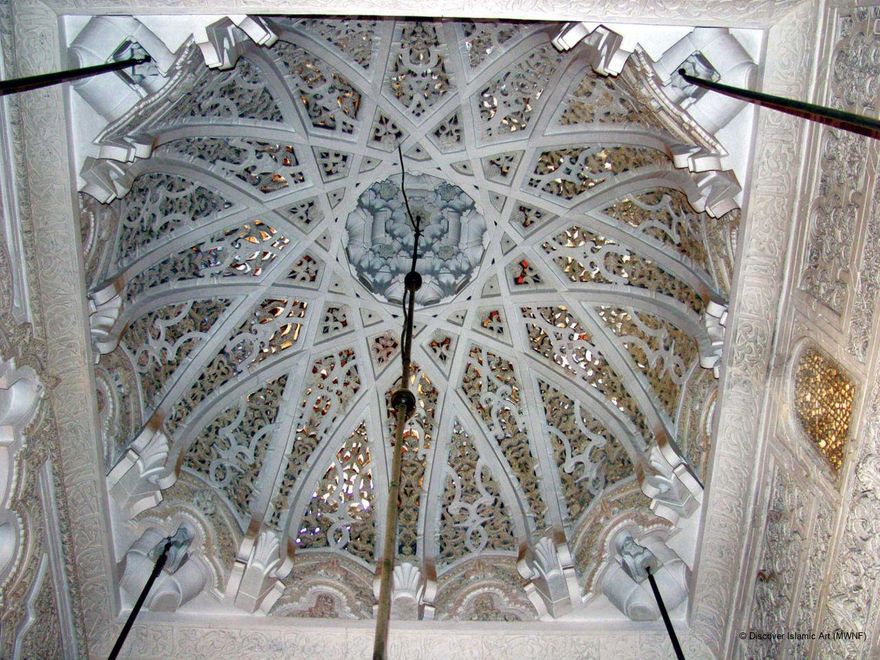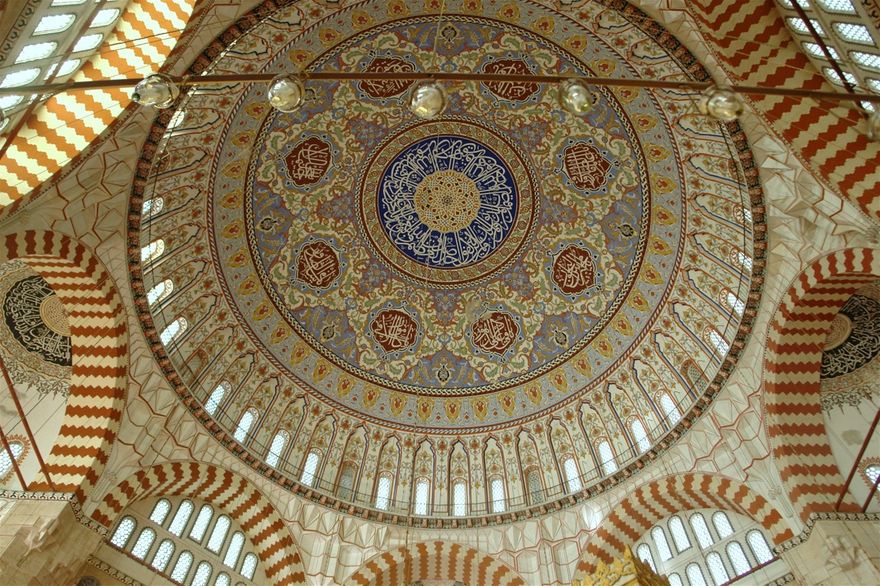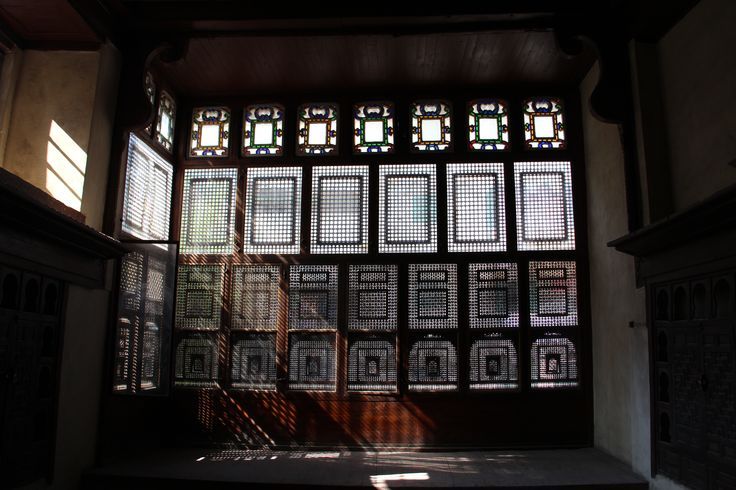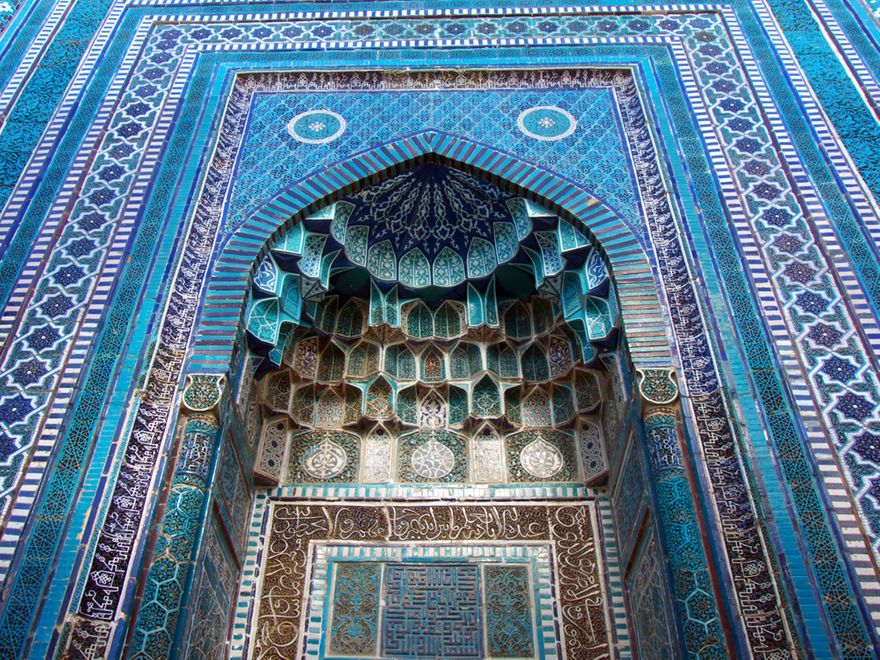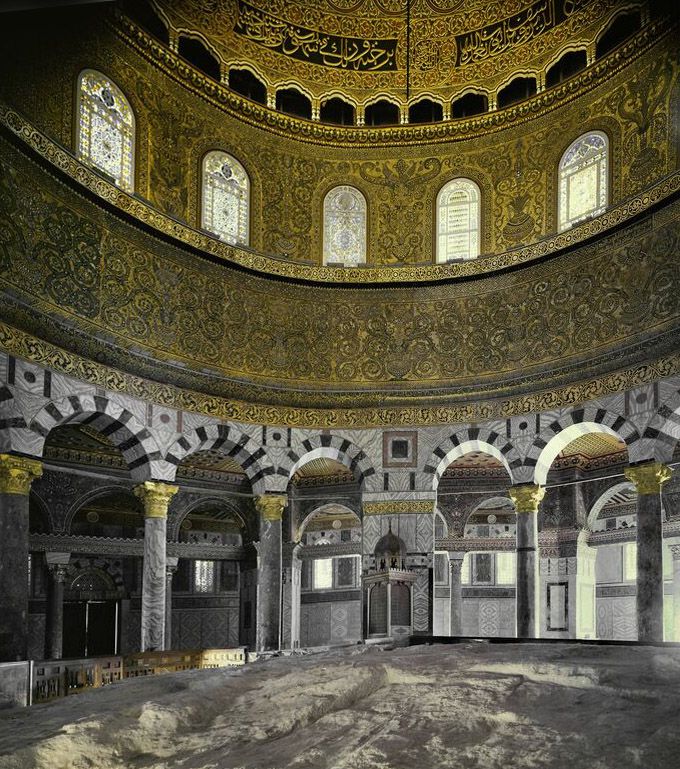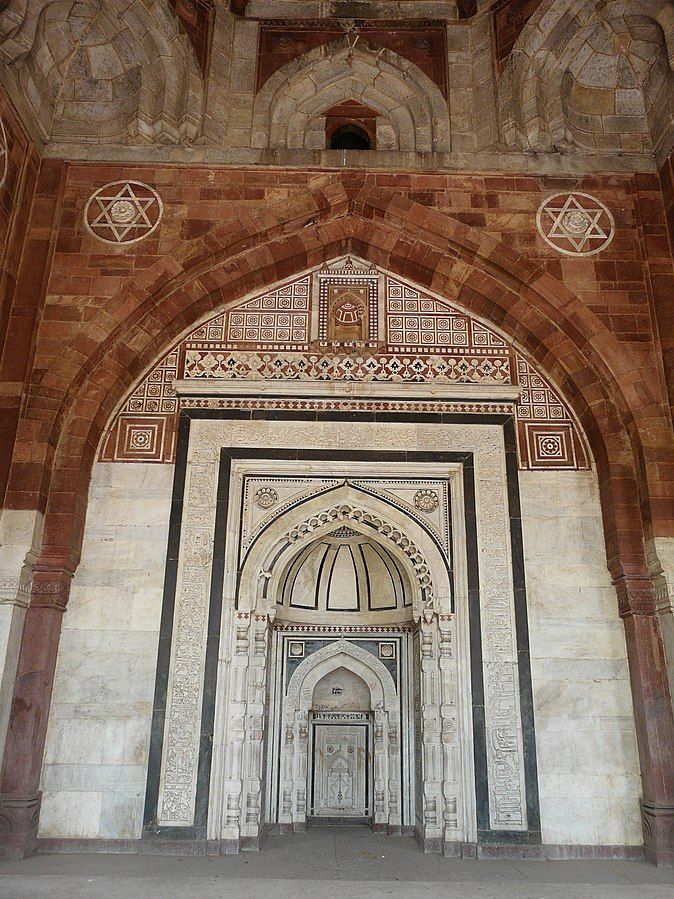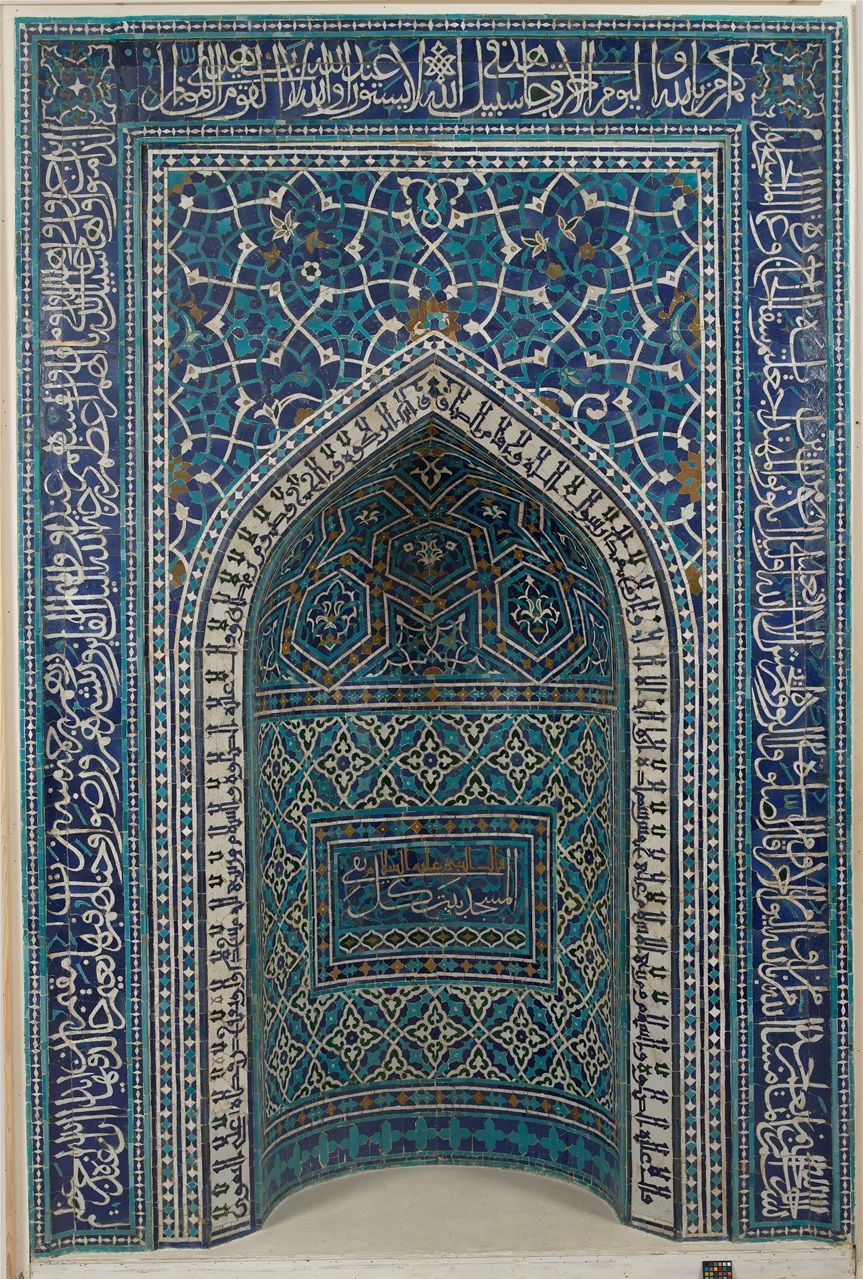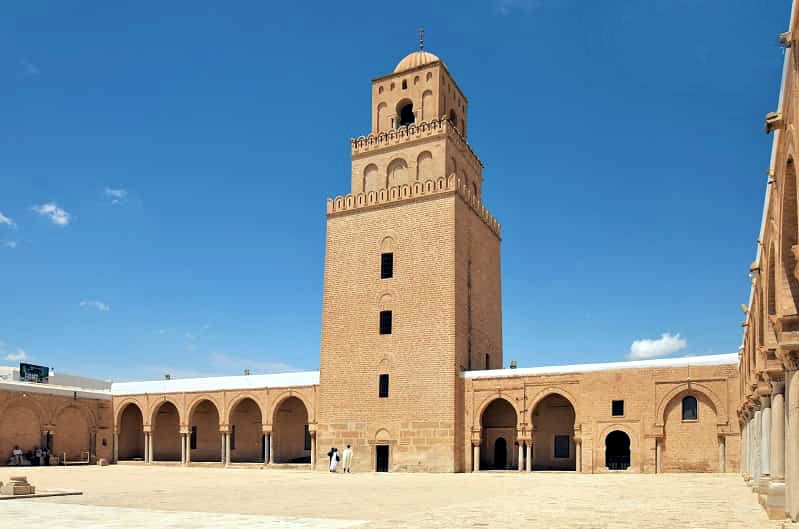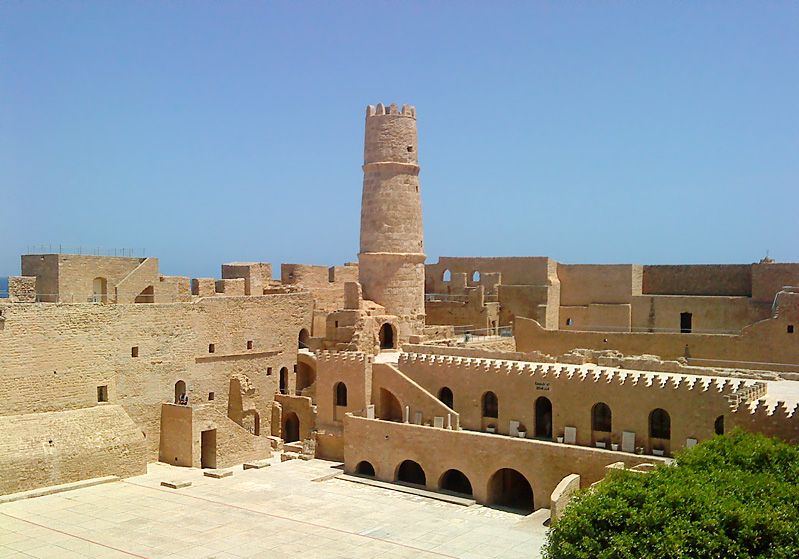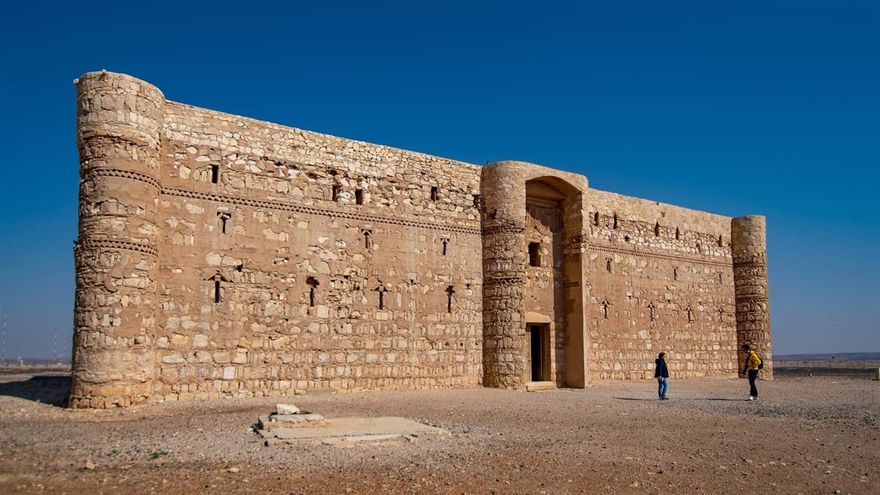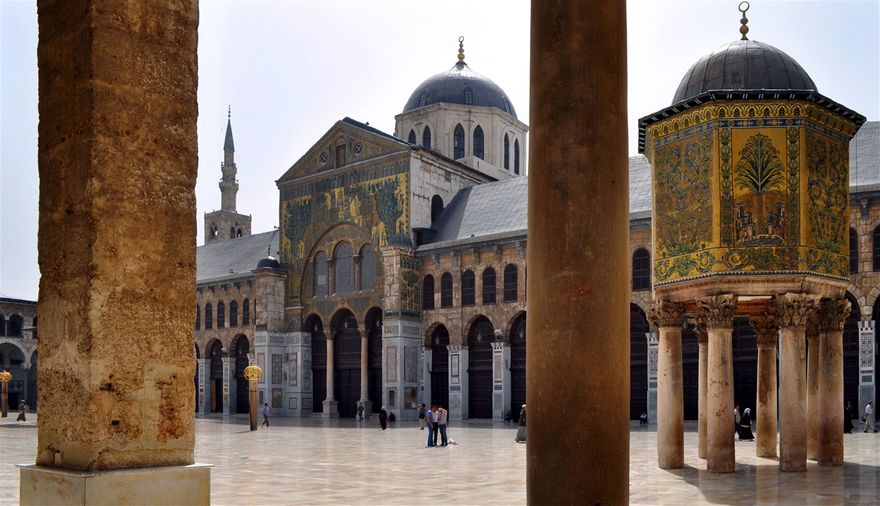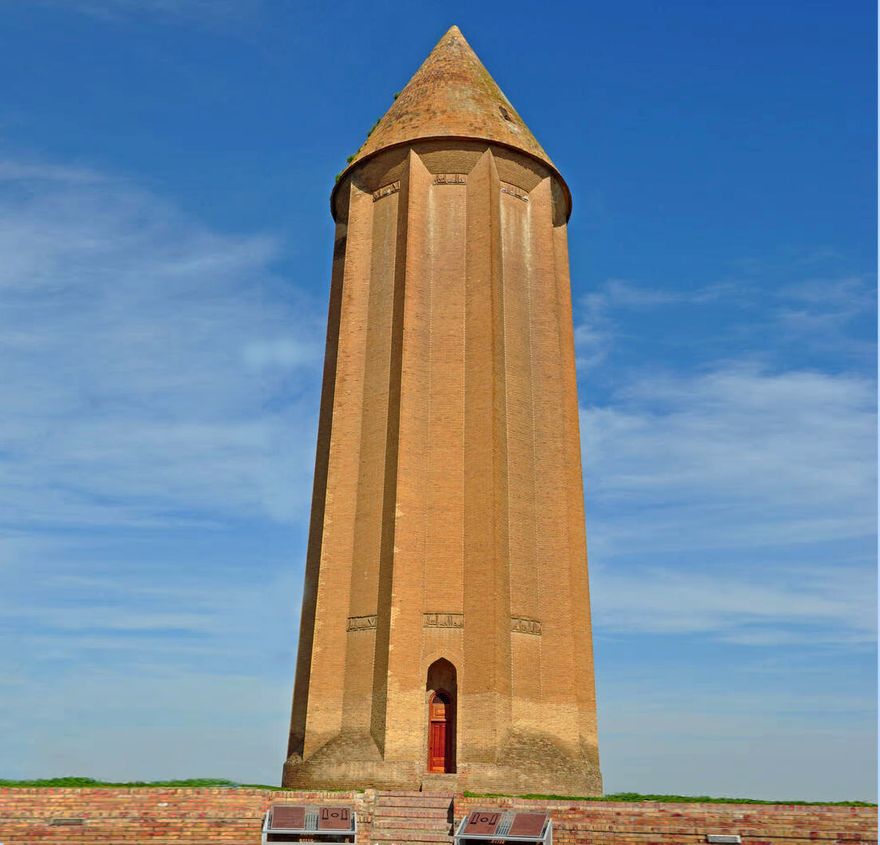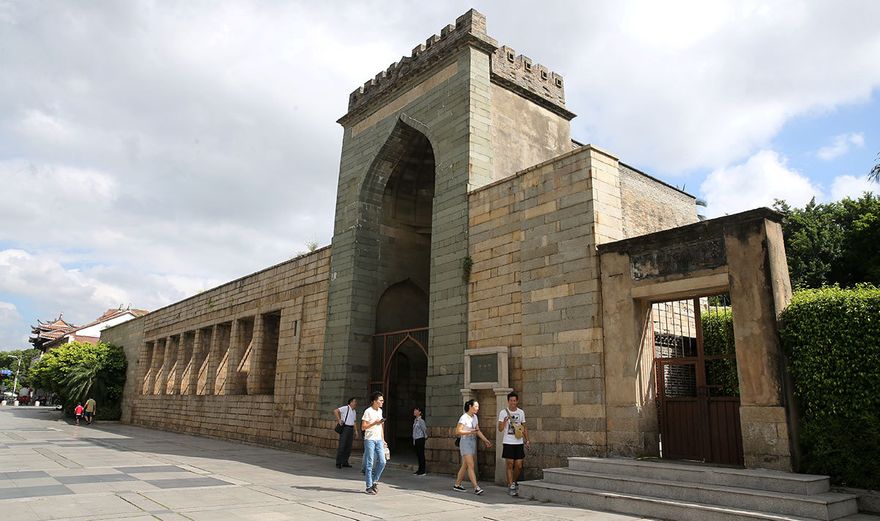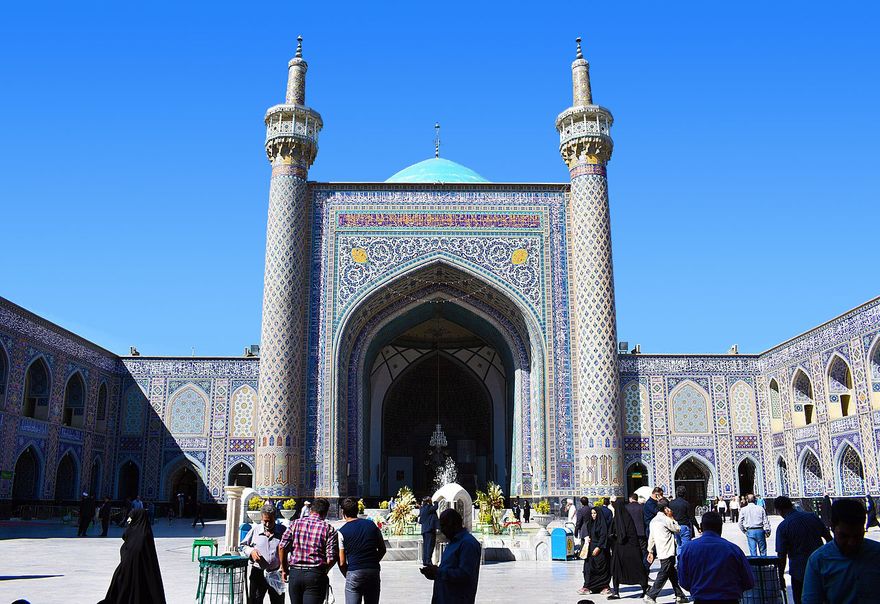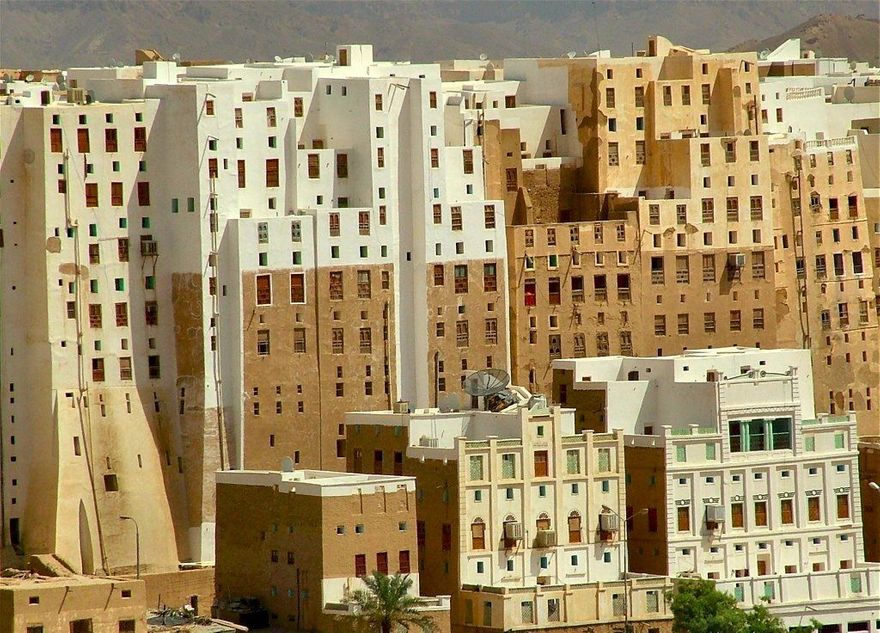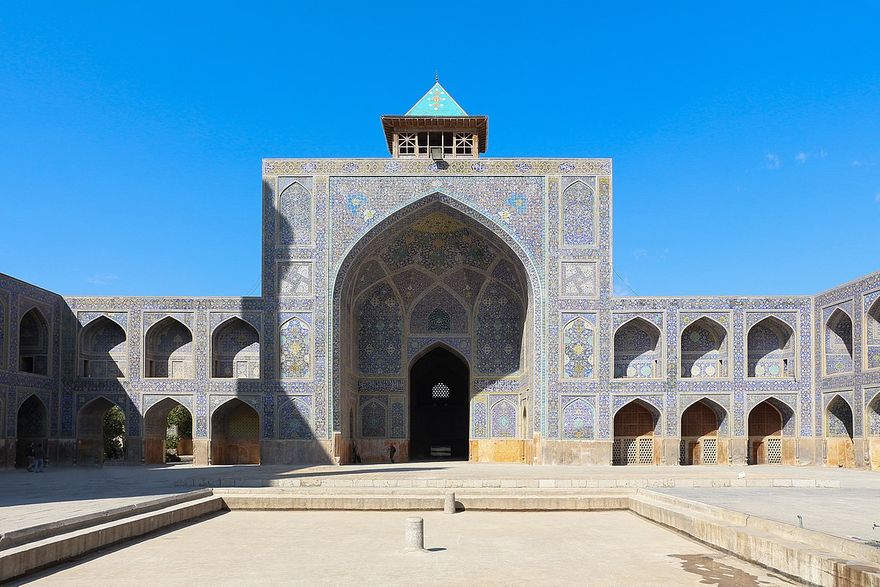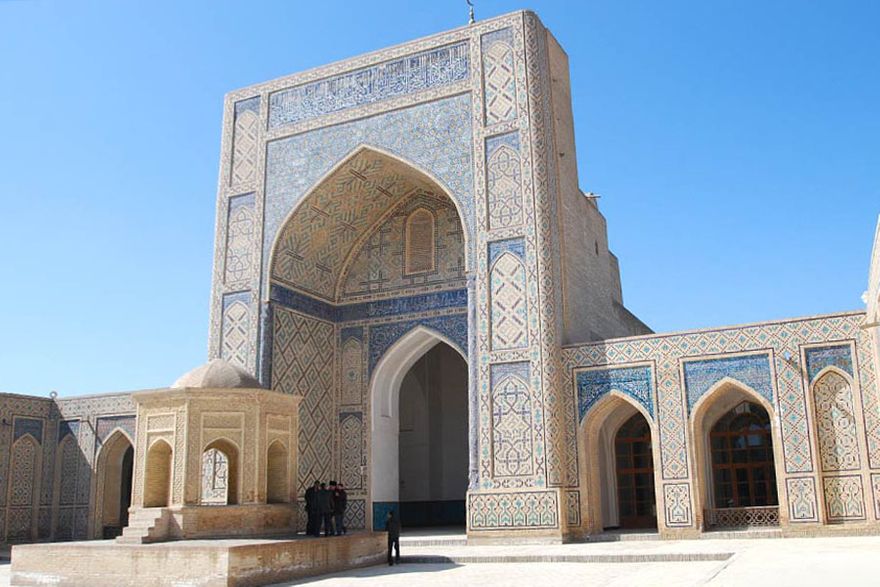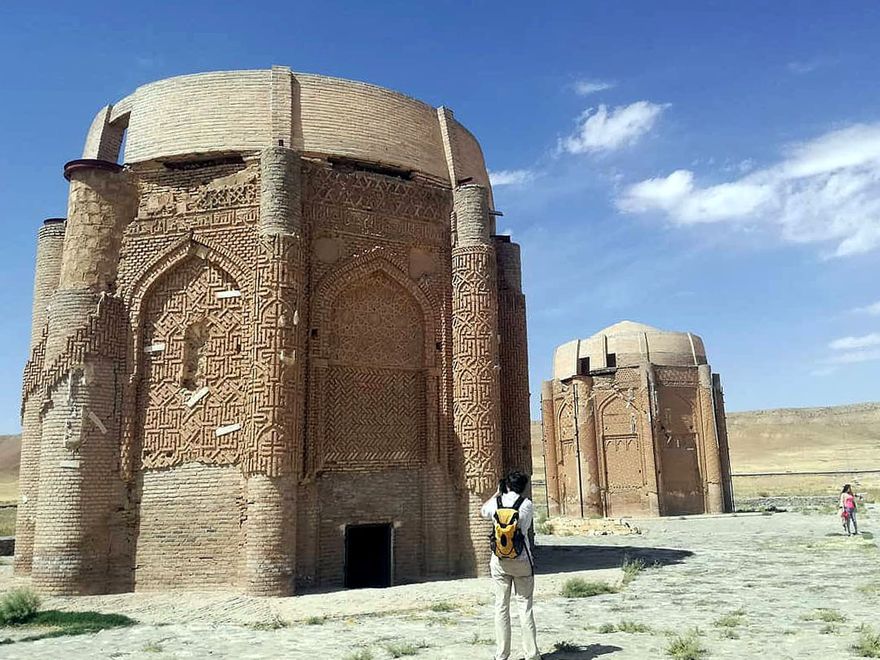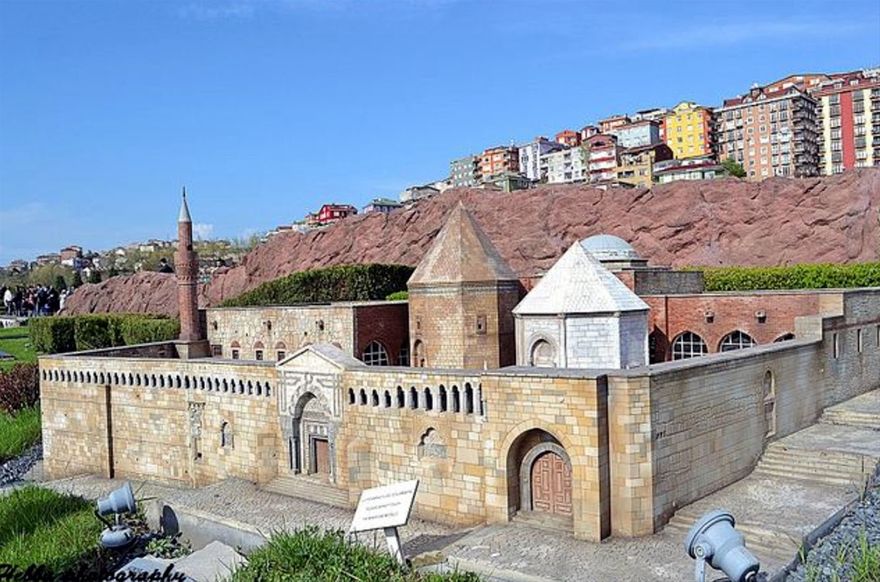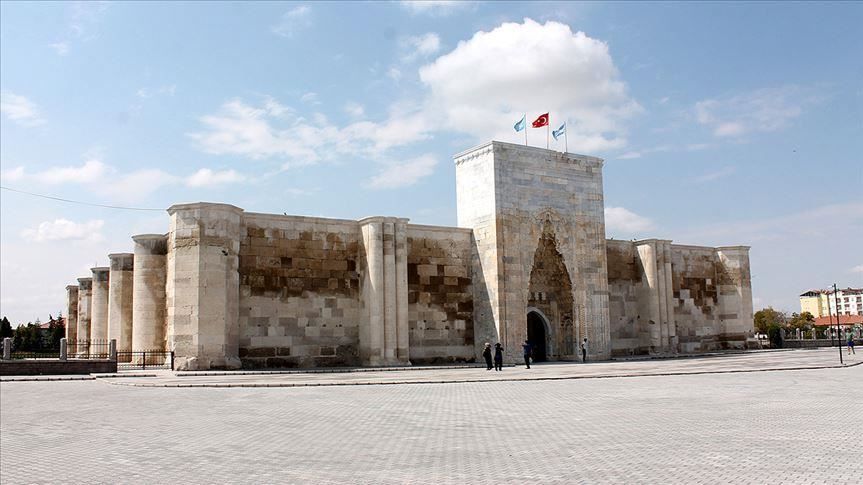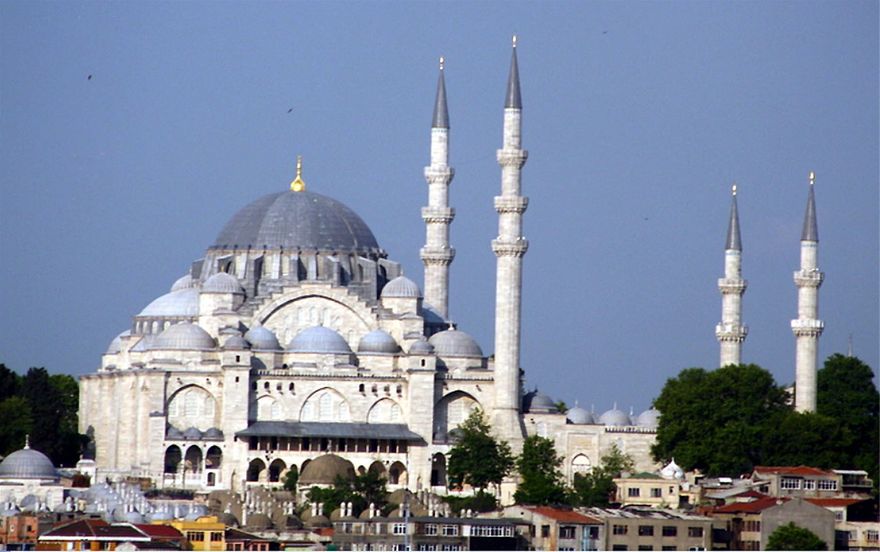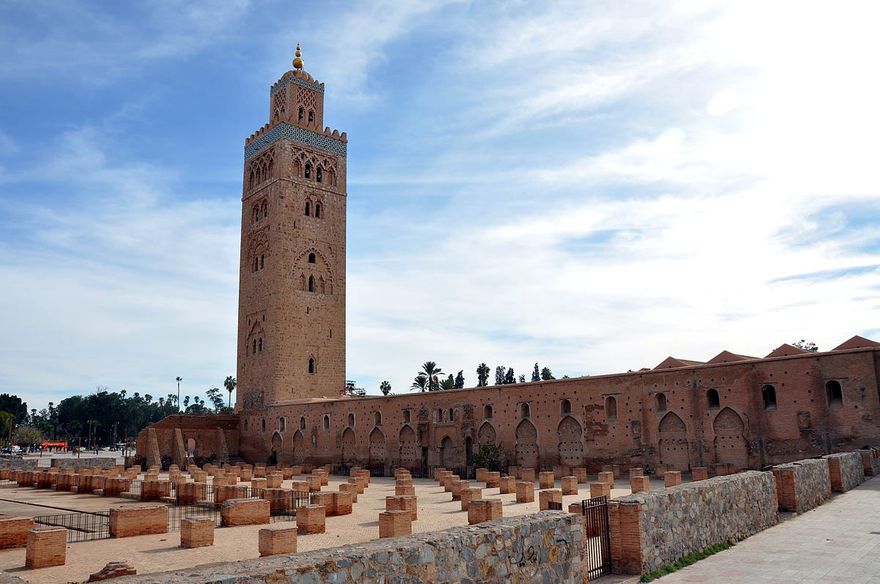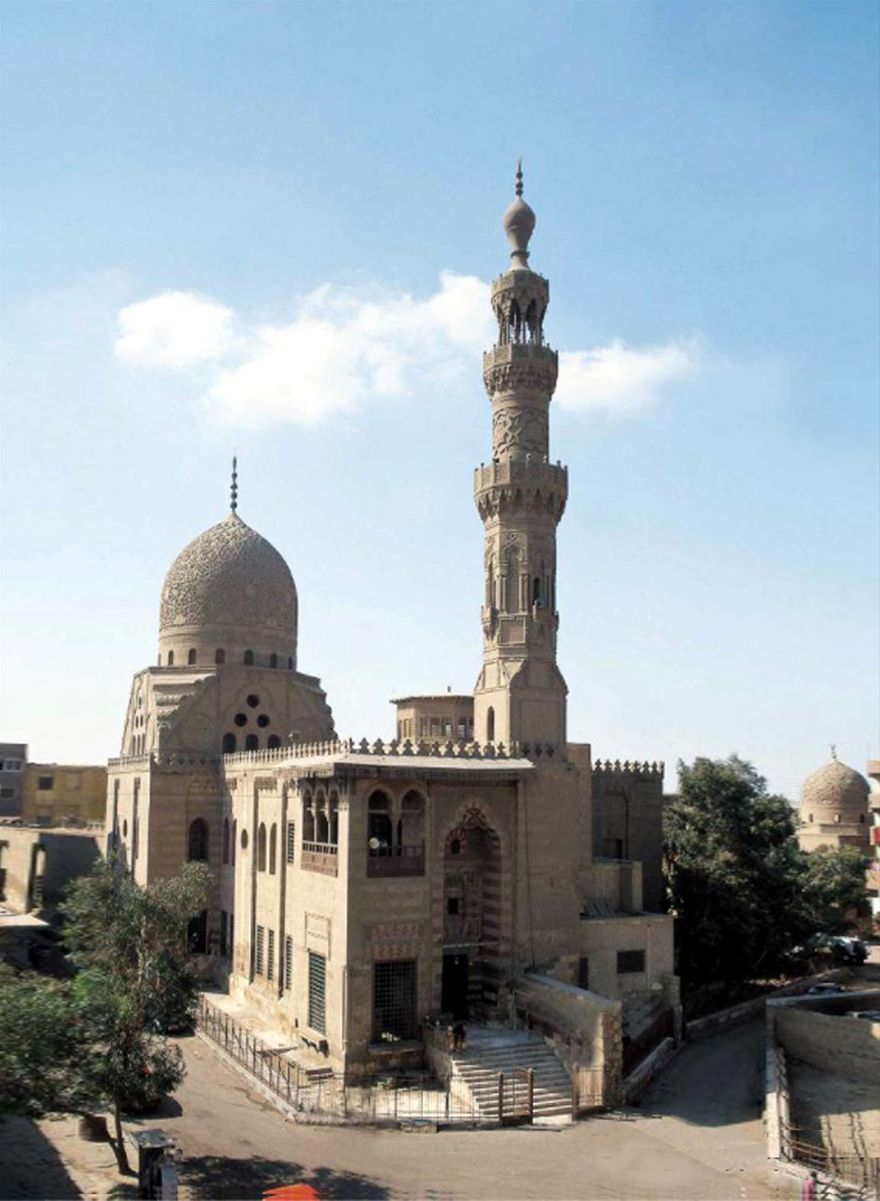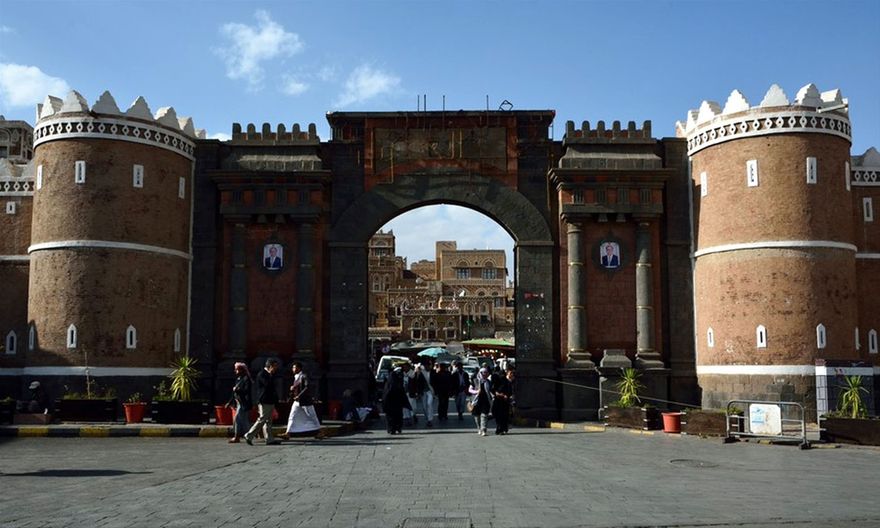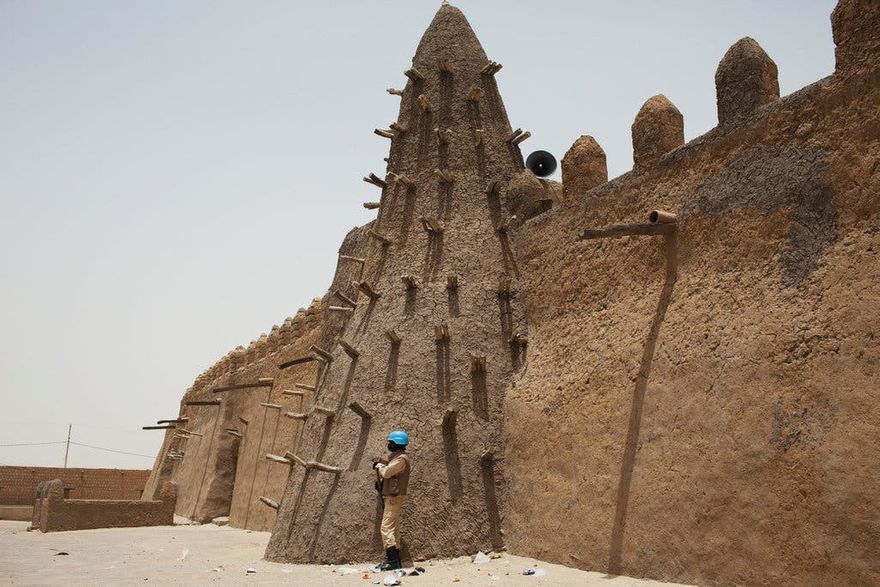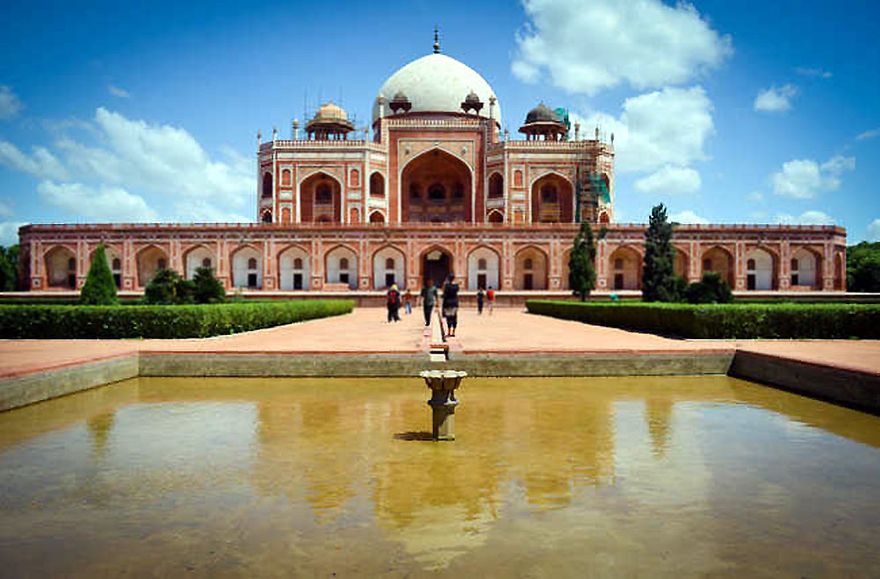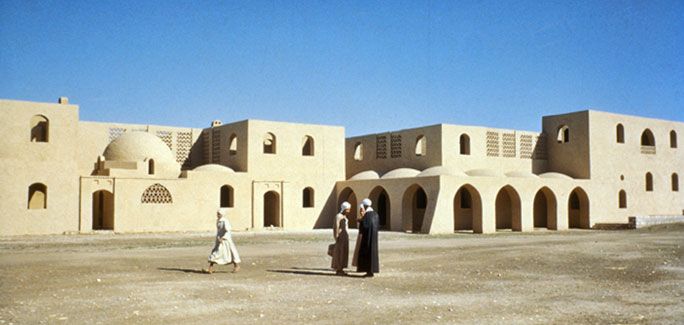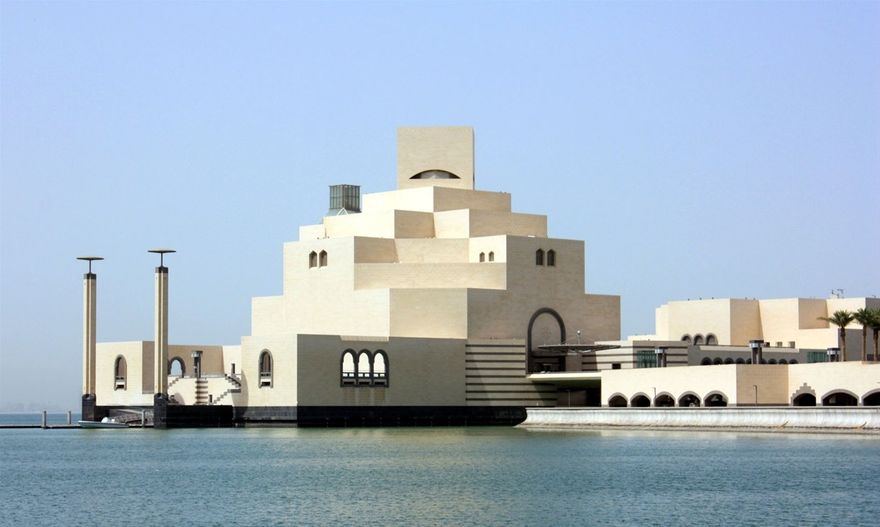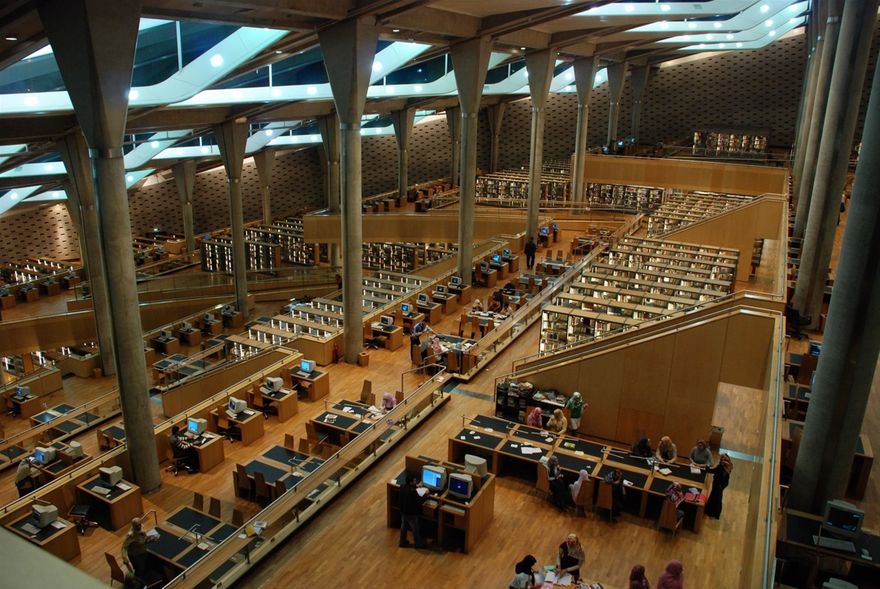Tesdorf Designs
Welcome to Architectural Information
ISLAMIC WORLD ARCHITECTURE
A RESOURCE FOR THE STUDY OF THE HISTORY AND THEORY OF ARCHITECTURE IN THE ISLAMIC WORLD
ISLAMIC ARCHITECTURE
Islamic architecture comprises the architectural styles of buildings associated with Islam. It encompasses both secular and religious styles from the early history of Islam to the present day. Islamic architecture developed to fulfill Islamic religious ideals, for example, the minaret was designed to assist the muezzin in making his voice heard throughout a specific area.
Early Islamic architecture was influenced by Roman, Byzantine, Persian, Mesopotamian architecture and all other lands which the Early Muslim conquests conquered in the seventh and eighth centuries. Further east, it was also influenced by Chinese and Indian architecture as Islam spread to Southeast Asia. Later it developed distinct characteristics in the form of buildings and in the decoration of surfaces with Islamic calligraphy, arabesques, and geometric motifs.
New architectural elements like minarets, muqarnas, and multifoil arches were invented. Common or important types of buildings in Islamic architecture include mosques, madrasas, tombs, palaces, hammams (public baths), Sufi hospices (e.g. khanqahs or zawiyas), fountains and sabils, commercial buildings (e.g. caravanserais and bazaars), and military fortifications.
The Sahaba Shrine located in the port area on Massawa Island, Eritrea was the first mosque in Africa 613 A.D..
EARLY HISTORY (UP TO 10TH CENTURY)
The Islamic era began with the formation of Islam in the 7th-century Arabia. The first mosque was a structure built by Muhammad in Medina in 622 A.D., right after his hegira (migration) from Mecca, which corresponds to the site of the present-day Mosque of the Prophet (al-Masjid an-Nabawi). The qibla was changed to face Mecca in 624 A.D. It became one of the main models for the early mosques built elsewhere.
There are few other buildings dating from the era of Muhammad, but one example is the Jawatha Mosque in Saudi Arabia. During the early Arab-Muslim conquests of the Middle East and North Africa in the 7th century, new garrison cities were established in territories such as Fustat in Egypt and Kufa in present-day Iraq. The central congregational mosques of these cities were built in the hypostyle format. In other cities, especially in Syria, new mosques were established by converting or occupying parts of existing churches in existing cities, for example in Damascus and Hama. These early mosques had no minaret, although small shelters may have been constructed on the roofs to protect the muezzin while issuing the call to prayer.
The Umayyad Caliphate (661–750 A.D.) combined elements of pre-Islamic Himyarite, Byzantine architecture, and Sasanian architecture, but Umayyad architecture introduced new combinations of these styles with considerable Ghassanid influence.
South Arabian architecture and styles of ornamentation represent an immediate predecessor of the early Umayyads. The reuse of elements from classical Roman and Byzantine art was still widely evident because political power and patronage were centered in Syria, a former Roman/Byzantine province. However, a significant amount of experimentation occurred as Umayyad patrons recruited craftsmen from across the empire, and architects were allowed or even encouraged, to mix elements from different artistic traditions and to disregard traditional conventions and restraints. Partly as a result of this, Umayyad architecture is distinguished by the extent and variety of decoration, including mosaics, wall painting, sculpture, and carved reliefs. While figural scenes were notably present in monuments like Qusayr 'Amra, non-figural decoration and more abstract scenes became highly favoured, especially in religious architecture.
The horseshoe arch appears for the first time in Umayyad architecture, later to evolve to its most advanced form in al-Andalus (Iberian Peninsula). In hypostyle mosques, the Umayyads introduced the tradition of making the "nave" or aisle in front of the mihrab wider than the others, dividing the prayer room along its central axis. They also added the mihrab to mosque design, a concave niche in the qibla wall of the mosque. The first mihrab, a concave niche in the qibla wall, reportedly appeared at Muhammad's mosque in Medina when it was rebuilt by al-Walid I in 707 A.D. It seems to have represented the place where the Prophet stood when leading prayer. This almost immediately became a standard feature of all mosques. Several major early monuments of Islamic architecture built under the Umayyads include the Dome of the Rock in Jerusalem (built by Caliph Abd al-Malik) and the Great Mosque of Damascus (built by al-Walid I).
The Al-Aqsa Mosque on the Haram al-Sharif, also in Jerusalem, was also rebuilt by al-Walid I, replacing an earlier simple structure built around 670 A.D. Both the Al-Aqsa Mosque and the Great Mosque of Damascus featured a hypostyle hall and a dome above the space in front of the mihrab, and both were influential in the design of later mosques elsewhere. A number of palaces from this period have also partially survived or have been excavated in modern times. The walls and minaret of the Great Mosque of Samarra were built by the Abbasids in the 9th Century A.D.
The Abbasid architecture of the Abbasid Caliphate (750–1513 A.D.) was particularly influenced by Sasanian architecture, which in turn featured elements present since ancient Mesopotamia. Other influences such as ancient Soghdian architecture in Central Asia have also been noted. This was partly a result of the caliphate's political center shifting further east to the new capital of Baghdad, in present-day Iraq. Abbasid mosques all followed the courtyard plan with hypostyle halls. The earliest was the mosque that Caliph al-Mansur built in Baghdad (since destroyed).
The Great Mosque of Samarra built by al-Mutawakkil was 256 by 139 metres (840 by 456 ft). A flat wooden roof was supported by columns. The mosque was decorated with marble panels and glass mosaics. The prayer hall of the Abu Dulaf Mosque at Samarra had arcades on rectangular brick piers running at right angles to the qibla wall. Both of the Samarra mosques have spiral minarets, the only examples in Iraq. A mosque at Balkh in what is now Afghanistan was about 20 by 20 metres (66 by 66 ft) square, with three rows of three square bays, supporting nine vaulted domes. While the origins of the minaret are uncertain, it is believed that the first true minarets appeared in this period. Several of the Abbasid mosques built in the early ninth Century A.D. had minaret towers that stood at the northern ends of the building, opposite the central mihrab. Among the most famous of these is the Malwiyya minaret, a stand-alone tower with a "spiral" form built for the Great Mosque of Samarra. The mihrab and maqsura area of the Great Mosque of Cordoba was added to the mosque by al-Hakam II in the late 10th century.
After the overthrow of the Umayyad Caliphate in 750 by the Abbasids, a new branch of the Umayyad dynasty succeeded in taking control of Al-Andalus in 756, creating the Emirate of Cordoba and reaching the apogee of its power during the Caliphate of Cordoba in the 10th Century A.D.. The Great Mosque at Córdoba, built in 785–786 A.D., marks the earliest major monument of Moorish architecture in the Iberian Peninsula (Al-Andalus). This style of architecture established in Al-Andalus was also largely shared with the architecture of western North Africa (the Maghreb), from which later empires in the region would also emerge and contribute to its artistic evolution. The original Great Mosque of Cordoba was noted for its unique hypostyle hall with rows of double-tiered, two-coloured, arches, which were repeated and maintained in later extensions of the building. The mosque was expanded multiple times, with the expansion by al-Hakam II (r. 961–976 A.D.) introducing important aesthetic innovations such as interlacing arches and ribbed domes, which were imitated and elaborated in later monuments in the region. The construction of Madinat al-Zahra, a new capital, and monumental palace-city in the 10th Century A.D., also created an important complex of royal architecture and patronage. Smaller monuments such as the early form of the Qarawiyyin Mosque in Fez (present-day Morocco) and the Bab al-Mardum Mosque in Toledo demonstrate the prevalence of the same stylistic elements across the region.
After its initial apogee of power, the Abbasid Caliphate became partly fragmented into regional states in the 9th Century A.D. which was formally obedient to the caliphs in Baghdad but were de facto independent. The Aghlabids in Ifriqiya (roughly modern-day Tunisia) were notable patrons of architecture themselves, responsible for rebuilding both the Great Mosque of Kairouan (originally founded by Uqba ibn Nafi in 670) and the Zaytuna Mosque of Tunis in much of their current forms, as well as for building numerous other structures in the region. In Egypt, Ahmad ibn Tulun established a short-lived dynasty, the Tulunids, and built himself a new capital (Al-Qata'i) and a new congregational mosque, known as the Ibn Tulun Mosque, which was completed in 879 A.D. It was strongly influenced by Abbasid architecture in Samarra and remains one of the most notable and best-preserved examples of 9th-Century A.D. architecture from the Abbasid Caliphate. Bab al-Futuh gate was built by the Fatimid Vazir Badr al-Jamali.
In the 10th Century A.D., the Fatimid Caliphate rose to power in Ifriqiya, where it built a new fortified capital at Mahdia. In 970 A.D. the Fatimids moved their center of power to Egypt and they founded another new capital, Cairo. Fatimid architecture in Egypt followed Tulunid techniques and used similar materials, but also developed those of their own. Their first congregational mosque in Cairo was the al-Azhar Mosque, founded at the same time as the city (970 A.D.), which became the spiritual center for the Ismaili Shi'a branch of Islam. Other notable monuments include the large Mosque of al-Hakim (founded in 990 under al-'Aziz but completed around 1013 A.D. under al-Hakim), the small Aqmar Mosque (1125 A.D.) with its richly-decorated street façade, and the domed Mashhad of Sayyida Ruqayya (1133 A.D.), notable for its mihrab of elaborately-carved stucco. Under the powerful vizier Badr al-Jamali (r. 1073–1094 A.D.), the city walls were rebuilt in stone along with several monumental gates, three of which have survived to the present-day: Bab al-Futuh, Bab al-Nasr, and Bab Zuweila).
Palace at Ctesiphon, Iraq built from the 3rd to 6th centuries A.D. The Brick Arch is an inverted Catenary Curve. The Arabs attacked Ctesiphon, and occupied it in early 637.A.D.
The Dome of the Rock in Jerusalem built 685-691/2 A.D. under Abdul al-Malik
Interior of Mosque at Cordoba, Spain constructed on the orders of Abd ar-Rahman I in 785 A.D.
The Spiral Minaret of Mosque at Samarra, Iraq 848-851 A.D.
Mosque of Ibn Tulun in Cairo, Egypt commissioned by Ahmad ibn Tulun, the Abbasid governor of Egypt from 868–884 A.D.
CHARACTERISTICS
Some characteristics of Islamic architecture were inherited from the pre-Islamic architecture of that region while some characteristics like minarets, muqarnas, arabesque, Islamic geometric motifs, pointed arch, multifoil arch, onion dome, and pointed dome developed later.
GARDENS
THE ISLAMIC GARDEN
Shalamar Gardens is a typical Mughal paradise garden in Lahore. Gardens and water have for many centuries played an essential role in Islamic culture, and are often compared to the garden of Paradise. The type originates from the Achaemenid Empire. In his dialogue "Oeconomicus", Xenophon has Socrates relate the story of the Spartan general Lysander's visit to the Persian prince Cyrus the Younger, who shows the Greek his "Paradise at Sardis". The classical form of the Persian Paradise garden, or the charbagh, comprises a rectangular irrigated space with elevated pathways, which divide the garden into four sections of equal size:
One of the hallmarks of Persian gardens is the four-part garden laid out with axial paths that intersect at the garden's centre. This highly structured geometrical scheme, called the chahar bagh, became a powerful metaphor for the organization and domestication of the landscape, itself a symbol of political territory.
A Charbagh from Achaemenid time has been identified in the archaeological excavations at Pasargadae. The gardens of Chehel Sotoun (Isfahan), Fin Garden (Kashan), Eram Garden (Shiraz), Shazdeh Garden (Mahan), Dowlatabad Garden (Yazd), Abbasabad Garden (Abbasabad), Akbarieh Garden (South Khorasan Province), Pahlevanpour Garden, all in Iran, form part of the UNESCO World Heritage. Large Paradise gardens are also found at the Taj Mahal (Agra), at Humayun's Tomb (New Delhi), in India; the Shalimar Gardens (Lahore, Pakistan), or at the Alhambra and Generalife in Granada, Spain.
COURTYARD (SAHN)
The sahn (courtyard) and minaret of the Great Mosque of Kairouan, Tunisia In the architecture of the Muslim world courtyards are found in secular and religious structures.
Residences and other secular buildings typically contain a central private courtyard or walled garden. This was also called the wast ad-dar ("middle of the house") in Arabic. The tradition of courtyard houses was already widespread in the ancient Mediterranean world and the Middle East, as seen in Greco-Roman houses (e.g. the Roman Domus). The use of this space included the aesthetic effects of plants and water, the penetration of natural light, allowing breezes and air circulation into the structure during the summer heat, as a cooler space with water and shade, and as a protected and proscribed place where the women of the house need not be covered in the hijab clothing traditionally necessary in public.
A ṣaḥn (Arabic: صحن) – is the formal courtyard found in almost every mosque in Islamic architecture. The courtyards are open to the sky and surrounded on all sides by structures with halls and rooms, and often a shaded semi-open arcade. A mosque courtyard is used for performing ablutions and as a patio for rest or gathering. Sahns usually feature a central pool or fountain to aid with ablutions, sometimes sheltered under an open domed pavilion. Historically, because of the warm Mediterranean and Middle Eastern climates, the courtyard also served to accommodate larger numbers of worshippers during Friday Prayers
HYPOSTYLE HALL
A Hypostyle, i.e., an open hall supported by columns, is considered to be derived from architectural traditions of Achaemenid period Persian assembly halls (apadana). This type of building originated from the Roman-style basilica with an adjacent courtyard surrounded by colonnades, like Trajan's Forum in Rome. The Roman type of building has developed out of the Greek agora. In Islamic architecture, the hypostyle hall is the main feature of the hypostyle mosque.
One of the earliest hypostyle mosques is the Tarikhaneh Mosque in Iran, dating back to the eighth century. Some scholars refer to the early hypostyle mosque with a courtyard as the "Arab plan" or "Arab-type" mosque. Such mosques were constructed mostly under the Umayyad and Abbasid dynasties; subsequently, however, the simplicity of this type of plan limited the opportunities for further development, and as a result, these mosques gradually fell out of popularity in some regions.
VAULTING
In Islamic buildings, vaulting follows two distinct architectural styles: While Umayyad architecture in the west continues Syrian traditions of the sixth and seventh century, eastern Islamic architecture was mainly influenced by Sasanian styles and forms.
Qusair 'Amra vaulting In their vaulting structures, Umayyad period buildings show a mixture of ancient Roman and Persian architectural traditions. Diaphragm arches with lintelled ceilings made of wood or stone beams, or, alternatively, with barrel vaults, were known in the Levant since the classical and Nabatean period. They were mainly used to cover houses and cisterns. The architectural form of covering diaphragm arches with barrel vaults, however, was likely newly introduced from Iranian architecture, as similar vaulting was not known in Bilad al-Sham before the arrival of the Umayyads. However, this form was well known in Iran from early Parthian times, as exemplified in the Parthian buildings of Aššur. The earliest known example for barrel vaults resting on diaphragm arches from Umayyad architecture is known from Qasr Harane in Syria.
During the early period, the diaphragm arches are built from coarsely cut limestone slabs, without using supporting falsework, which was connected by gypsum mortar. Later-period vaults were erected using pre-formed lateral ribs modeled from gypsum, which served as a temporal formwork to guide and center the vault. These ribs, which were left in the structure afterward, do not carry any load. The ribs were cast in advance on strips of cloth, the impression of which can still be seen in the ribs today. Similar structures are known from Sasanian architecture, for example from the palace of Firuzabad. Umayyad-period vaults of this type were found in Amman Citadel and in Qasr Amra.
IWANS
An iwan in the Jameh Mosque of Isfahan The term iwan denotes a hall that is walled on three sides and opens on one side. It is typically covered by a vault although this can vary. This feature was present in Sasanian architecture, though its exact origins are older and still debated. It was later incorporated into Islamic architecture. Its usage became more common and widespread under the Seljuks in the 10th century. Iwans were used in a variety of ways and arranged in varying positions in relation to the rest of the building. They are found in many types of buildings including mosques, madrasas, palaces, and caravanserais. One characteristic layout consists of four iwans arranged around a central square or rectangular courtyard, with the iwans aligned with the central axes of the courtyard.
For mosques and madrasas, one of the iwans could be oriented towards the qibla (direction of prayer) and include a mihrab in order to serve as a prayer space.] The related Persian term, pishtaq, is used to denote an entrance portal (sometimes an iwan) projecting from the façade of a building, often decorated with calligraphy bands, glazed tilework, and geometric designs.
DOMES
Because of its long history of building and re-building, spanning the time from the Abbasids to the Qajar dynasty, and its excellent state of conservation, the Jameh Mosque of Isfahan provides an overview of the experiments Islamic architects conducted with complicated vaulting structures.
The system of squinches, which is a construction filling in the upper angles of a square room so as to form a base to receive an octagonal or spherical dome, was already known in Sasanian architecture. The spherical triangles of the squinches were split up into further subdivisions or systems of niches, resulting in a complex interplay of supporting structures forming an ornamental spatial pattern that hides the weight of the structure.
The tradition of double-shelled brick domes in Iran has been traced back to the 11th century. At the beginning of the 15th Century A.D., major Timurid monuments like the Gur-i Amir Mausoleum and the Bibi Khanum Mosque (both completed around 1404 A.D.) were notable in their use of large double-shelled domes. These domes were composed of an inner shell that was visible from the interior and a larger outer shell, visible from the exterior and often of a slightly different shape. The Gur-i Amir Mausoleum's dome, the oldest one to have survived to the present day, features an exterior ribbed profile with a band of muqarnas around its drum. However, domes of this shape and style were likely constructed earlier, as evidenced by the Sultaniyya Mausoleum in Cairo, which was built earlier in the 1350s A.D. and appears to have copied this same design from the Iranian tradition.
The "non-radial rib vault", an architectural form of ribbed vaults with a superimposed spherical dome, is the characteristic architectural vault form of the Islamic East. From its beginnings in the Jameh Mosque of Isfahan, this form of the vault was used in a sequence of important buildings up to the period of Safavid architecture. Its main characteristics are:
1. four intersecting ribs, at times, redoubled and intersected to form an eight-pointed star;
2. the omission of a transition zone between the vault and the supporting structure;
3. a central dome or roof lantern on top of the ribbed vault.
While intersecting pairs of ribs from the main decorative feature of Seljuk architecture, the ribs were hidden behind additional architectural elements in later periods, as exemplified in the dome of the Tomb of Ahmed Sanjar in Merv, until they finally disappeared completely behind the double shell of a stucco dome, as seen in the dome of Ālī Qāpū in Isfahan.
Shālāmār Bāgh are a Mughal garden located in Lahore, Pakistan. 1641-1642 A.D.
Courtyard of the Great Mosque of Kairouan, Tunisia founded 670 A.D.
Interior of Tarikhaneh Mosque in Damghan, Iran. 750 AH and 690 A.D.
Vault of Qasr Amr, Syria, built between 723 & 743 A.D., by Walid Ibn Yazid, Umayyad caliph Walid II
Iwan of the Jameh Mosque of Isfahan built from 771 A.D.
The Gur-i Amir Mausoleum's dome at Samarkand, Uzbekistan, built 1404 A.D.
RIBBED DOMES IN AL-ANDALUS & THE MAGHREB
Ribbed dome in the Mosque-Cathedral of Córdoba, dating from the 10th Century A.D. The Great Mosque of Córdoba in Al-Andalus was initially built with a system of double-arched arcades supporting the flat timberwork ceiling. The columns of the arcades are connected by horseshoe arches that support brick pillars, which are in turn interconnected by semicircular arches. In the 10th-Century A.D. additions to the mosque changes were introduced into the basic architectural design: horseshoe arches were now used for the upper row of arcades, which were now supported by five-pass arches. In sections that now supported domes, additional supporting structures were needed to bear the thrust of the cupolas. The architects solved this problem by the construction of intersecting three- or five-pass arches. The three domes spanning the vaults in front of the mihrab wall are constructed as ribbed vaults. Rather than meeting in the centre of the dome, the ribs intersect one another off-centre, forming an eight-pointed star in the centre.
The ribbed domes of the Mosque-Cathedral of Córdoba served as models for later mosque buildings in the Islamic West of Al-Andalus and the Maghreb. At around 1000 A.D., the Bab al-Mardum Mosque in Toledo was constructed with a similar, eight-ribbed dome, surrounded by eight other ribbed domes of varying design. Similar domes are also seen in the mosque building of the Aljafería of Zaragoza. The architectural form of the ribbed dome was further developed in the Maghreb: the central dome of the Great Mosque of Tlemcen, a masterpiece of the Almoravids founded in 1082 A.D., has twelve slender ribs, the shell between the ribs is filled with filigree stucco work.
OTTOMAN DOMES
Sultan Ahmed Mosque Based on the model of pre-existing Byzantine domes, Ottoman architecture developed a specific form of monumental, representative building: wide central domes with huge diameters were erected on top of a centre-plan building. Despite their enormous weight, the domes appear virtually weightless. Some of the most elaborate domed buildings have been constructed by the Ottoman architect Mimar Sinan.
When the Ottomans had conquered Constantinople, they found a variety of Byzantine Christian churches, the largest and most prominent amongst them was the Hagia Sophia. The brickwork-and-mortar ribs and the spherical shell of the central dome of the Hagia Sophia were built simultaneously, as a self-supporting structure without any wooden centring. In the early Byzantine church of Hagia Irene, the ribs of the dome vault are fully integrated into the shell, similar to Western Roman domes, and thus are not visible from within the building. In the dome of the Hagia Sophia, the ribs and shell of the dome unite in a central medallion at the apex of the dome, the upper ends of the ribs being integrated into the shell; shell and ribs form one single structural entity.
In later Byzantine buildings, like the Kalenderhane Mosque, the Eski Imaret Mosque (formerly the Monastery of Christ Pantepoptes) or the Pantokrator Monastery (today Zeyrek Mosque), the central medallion of the apex and the ribs of the dome became separate structural elements: the ribs are more pronounced and connect to the central medallion, which also stands out more pronouncedly, so that the entire construction gives the impression as if ribs and medallion are separate from, and underpin, the proper shell of the dome. Elaborately decorated ceilings and dome interiors draw influence from Near Eastern and Mediterranean architectural decoration while also serving as explicit and symbolic representations of the heavens. These dome-shaped architectural features could be seen at the early Islamic palaces such as Qusayr ῾amra (c.712–15 A.D.) and Khirbat al-mafjar (c.724–43 A.D.).
Mimar Sinan solved the structural issues of the Hagia Sophia dome by constructing a system of centrally symmetric pillars with flanking semi-domes, as exemplified by the design of the Süleymaniye Mosque (four pillars with two flanking shield walls and two semi-domes, 1550–1557 A.D.), the Rüstem Pasha Mosque (eight pillars with four diagonal semi-domes, 1561–1563 A.D.), and the Selimiye Mosque in Edirne (eight pillars with four diagonal semi-domes, 1567/8–1574/5 A.D.). In the history of architecture, the structure of the Selimiye Mosque has no precedent. All elements of the building are subordinate to its great dome.
BALCONIES AND SCREENS
Balconies are a common feature of Islamic domestic architecture due to the warm climates in most countries. One of the mosque's recognizable types is the mashrabiya, a wooden lattice screen that projects from the side of a building and which protected privacy by allowing those inside to look outside without being visible from outside. Another type of lattice screen, not restricted to balconies, is the jali, which is common to Indo-Islamic architecture and is made of perforated stone. Other examples of balconies and related structures include the jharokha in Rajasthani and Indo-Islamic architecture and the mirador, a Spanish term applied to a balcony or lookout pavilion in Andalusi palaces like the Alhambra. Balconies also became an architectural element inside some mosques, such as the hünkâr mahfili in Ottoman mosques, a separate and protected space where the sultan could perform his prayers (similar to a maqsura). A similar feature is also found in the Bara Gunbad complex (late 15th Century A.D.) in Delhi and the Mashrabiya balcony in Bayt al-Suhaymi, Cairo (Egypt)
MUQARNAS
The architectural element of muqarnas developed in northeastern Iran and the Maghreb around the middle of the 10th Century A.D. The ornament is created by the geometric subdivision of a vaulting structure into miniature, superimposed pointed-arch substructures, also known as "honeycomb", or "stalactite" vaults. Made from different materials like stone, brick, wood or stucco, its use in architecture spread over the entire Islamic world. In the Islamic West, muqarnas are also used to adorn the outside of a dome, cupola, or similar structure, while in the East is more limited to the interior face of a vault. Muqarnas are seen in the necropolis of Shah-i-Zinda, Samarqand and the Muqarnas in the Alhambra
Dome of the Great Mosque of Tlemcen, Algeria, 1082 A.D.
Dome of the Selimiye Mosque, Edirne designed by the architect Mimar Sinan, 1568-1575 A.D..
Mashrabiya balcony in the Bayt al-Suhaymi House, Cairo
Muqarnas from the necropolis of Shah-i-Zinda, Samarkand, Uzbekistan 1361 A.D.
ORNAMENTATION
ISLAMIC ORNAMENT
As a common feature, Islamic architecture makes use of specific ornamental forms, including mathematically complicated, elaborate geometric patterns, floral motifs like the arabesque, and elaborate calligraphic inscriptions, which serve to decorate a building, specify the intention of the building by the selection of the textual program of the inscriptions. The calligraphic inscriptions adorning the inner frieze of the Dome of the Rock include verses similar to the Quran (e.g., Quran 19:33–35) which reference the miracle of Jesus and his human nature in an Islamic manner.
The geometric or floral, interlaced forms, taken together, constitute an infinitely repeating pattern that extends beyond the visible material world. To many in the Islamic world, they symbolize the concept of the infinite proof of the existence of one eternal God. Furthermore, the Islamic artist conveys a definite spirituality without the iconography of Christian art. Non-figural ornaments are used in mosques and buildings around the Muslim world, and it is a way of decorating using beautiful, embellishing, and repetitive Islamic art instead of using pictures of humans and animals (which some Muslims believe is forbidden (Haram) in Islam.
Capitals are the upper part or crowning feature of a column or pilaster. They serve as a transition piece between the shaft of the structure and the element it supports. Capitals range greatly in design and shape in Islamic Architecture. Early Islamic buildings in Iran featured “Persian” type capitals which included designs of bulls heads, while Mediterranean structures displayed a more classical influence.
OTHER ELEMENTS OF RELIGIOUS ARCHITECTURE
QIBLA ORIENTATION
The qiblah (Arabic: قِـبْـلَـة) is the direction in which Mecca is from any given location, and within Islamic architecture it is a major component of both the features and the orientation of the building itself. Ancient Islamic cities and the mihrab in mosques were meant to be built facing in this direction, yet when actually observing the layout of such areas they do not all point to the same place. This is due to discrepancies in the calculations of the Islamic scientists in the past who determined where Mecca was from their individual locations. Scholars note that these differences come about for a multitude of reasons, such as some misunderstanding the meaning of qibla itself, the fact that the political situation affected the object of the direction of the qibla, and that the determination of this direction was more an astronomical calculation, rather than a mathematical one.
Early mosques were constructed with a qiblah to face Petra by accurate calculations of direction. Later mosques were constructed with qiblahs that faced various directions such as Jerusalem, or the South. Mecca is located to the south of Medina where Mohammed dwelled. Finally, all mosques had qiblas orientated so that the mihrab faced Mecca from wherever the mosque was built.
MIHRAB
The mihrab is a niche or alcove, typically concave, set into the qibla wall (the wall standing in the direction of prayer) of a mosque or other prayer space. It symbolized and indicated the direction of the qibla to worshippers. It also acquired ritual and ceremonial importance over time, and its shape was even used as a symbol on some coinage. The very first mosques did not have mihrabs; the first known concave mihrab niche was the one added to the Prophet's Mosque in Medina by Caliph al-Walid I in 706 or 707 A.D.. In later mosques, the mihrab evolved to become the usual focus of architectural decoration in the building. The details of its shape and materials varied from region to region. In congregational mosques, the mihrab was usually flanked by a minbar (pulpit), and some historical mosques also included a nearby maqsura (a protected space for the ruler during prayers).
MINARET
The minaret is a tower that traditionally accompanies a mosque building. Its formal function is to provide a vantage point from which the call to prayer, or adhan, is made. The call to prayer is issued five times each day: dawn, noon, mid-afternoon, sunset, and night. In most modern mosques, the adhān is made directly from the prayer hall and broadcast via microphone to a speaker system on the minaret.
The earliest mosques lacked minarets, and the call to prayer was often performed from smaller tower structures. Hadiths relay that the early Muslim community of Medina gave the call to prayer from the roof of the house of Muhammad, which doubled as a place for prayer. Scholarly findings trace the origin of minarets to the Umayyad Caliphate and explain that these minarets were a copy of church steeples found in Syria in those times. The first minarets were derived architecturally from the Syrian church tower. Other references suggest that the towers in Syria originated from ziggurats of Babylonian and Assyrian shrines of Mesopotamia. The first known minarets appear in the early 9th Century A.D. under Abbasid rule and were not widely used until the 11th Century A.D. These early minaret forms were originally placed in the middle of the wall opposite the qibla wall. The minaret of the Great Mosque of Kairouan in Tunisia (early 9th century A.D.) is considered to be the oldest surviving minaret in the world. It has the shape of a massive tower with a square base, three levels of decreasing widths, and a total height of 31.5 metres.
Minarets have had various forms (in general, round, squared, spiral or octagonal) depending on the period and architectural tradition. The number of minarets by mosques is not fixed; originally one minaret would accompany each mosque, but some architectural styles can include multiple minarets.
Interior of the Dome of the Rock in Jerusalem built in 691–692 A.D.
Qibla in the Qila-i-Kuhna mosque, central bay with mihrab located in the Purana Qila (Old Fort) in Delhi, India, 1538-1545 A.D.
Mihrab in thE Metropolitan Museum in New York dated 1354–1355 A.D.
The minaret of the Great Mosque of Kairouan in Tunisia 863 A.D.
TOWNS AND CITIES URBAN MORPHOLOGY OF THE MEDINA
The architecture of the "oriental"-Islamic town is based on cultural and sociological concepts which differ from those of European cities. In both cultures, a distinction is made between the areas used by the rulers and their government and administration, public places of everyday common life, and the areas of private life. While the structures and concepts of European towns originated from a sociological struggle to gain basic rights of freedom—or town privileges—from political or religious authorities during the Middle Ages, an Islamic town or city is fundamentally influenced by the preservation of the unity of secular and religious life throughout time.
In a medina, palaces, and residences as well as public places like mosque-madrasa-hospital complexes and private living spaces rather coexist alongside each other. The buildings tend to be more inwardly oriented, and are separated from the surrounding "outside" either by walls or by the hierarchical ordering of the streets, or both. Streets tend to lead from public main roads to cul-de-sac byroads and onwards into more private plots, and then end there. There are no, or very few, internal connections between different quarters of the city. In order to move from one quarter to the next, one has to go back to the main road again.
Within a city quarter, byroads lead towards individual building complexes or clusters of houses. The individual house is frequently also oriented towards an inner atrium, and enclosed by walls, which mostly are unadorned, unlike European outward-oriented, representative facades. Thus, the spatial structure of a medina essentially reflects the ancient nomadic tradition of living in a family group or tribe, held together by asabiyya, strictly separated from the "outside". In general, the morphology of an Islamic medina is granting—or denying—access according to the basic concept of hierarchical degrees of privacy. The inhabitants move from public space to the living quarters of their tribe, and onwards to their family home. Within a family house, there are again to be found common and separate spaces, the latter, and most private, usually reserved for women and children. In the end, only the family heads have free and unlimited access to all rooms and areas of their private home, as opposed to the more European concept of interconnecting different spaces for free and easy access. The hierarchy of privacy thus guides and structures the entire social life in a medina, from the caliph down to his most humble subject, from the town to the house.
MISR, OR RIBAT
In the frontier area of the Arabic expansion, military forts (Misr, Pl. Arabic: أَمْـصَـار, amṣār), or Ribāṭ (Arabic: رِبَـاط, fortress) were founded. The structure and function of a misr is similar to an ancient Roman Colonia. Like a frontier colony, the fortress served as a base for further conquests. Arabian military forts of this type were frequently built in the vicinity of an older town from Antiquity or from Byzantine times. They frequently were of square format. Rather than maintaining their original purpose to serve as a military base, many amṣār developed into urbane and administrative centers. In particular, this happened in the case of the Iraqi cities of Kufa and Basra, which became known as "al-miṣrān" ("the two forts"), but also with Fustat and Kairouan in North Africa.
QAṢR
Qaṣr (Arabic: قَصْـر; Pl. Arabic: قصور, quṣūr) means palace, castle or (frontier) fort. Fortresses from Late Antiquity often continued to be in use, while their function changed over time. Some quṣūr were already used as Castra during Roman times and were part of the fortifications of the North African limes. Already during the Ancient Roman times, castra did not only serve as fortifications but also as markets and meeting points for the tribes living beyond the border.
Smaller quṣūr are found in modern Jordan and include Qasr Al-Hallabat (located 50 km (31 mi) east of Amman), Qasr Bushir (15 km (9.3 mi) north of Lajjun), the castle of Daganiya (45 km (28 mi) north of Ma'an) and Odruh (22 km (14 mi) east of Wadi Musa). After the Limes Arabicus was abandoned by the Roman Empire, many of the castra continued to be in use. This continuity was subject to archaeological investigations in the fort of Qasr al-Hallabat, which at different times served as a Roman castrum, Christian cenobitic monastery, and finally as an Umayyad Qasr.] Qasr Al-Kharanah is one of the earliest known Desert castles, its architectural form clearly demonstrates the influence of Sasanian architecture.
According to a hypothesis developed by Jean Sauvaget, the Umayyad quṣūr played a role in the systematic agricultural colonisation of the uninhabited frontier areas, and, as such, continue the colonisation strategy of earlier Christian monks and the Ghassanids. The Umayyads, however, increasingly oriented their political strategy towards a model of Client politics, of mutual interdependence and support. After the Umayyad conquest, the quṣūr lost their original function and were either abandoned or continued to serve as local market places and meeting points until the 10th Century A.D. Another type of Islamic fortress is the Qalat.
INFLUENCES
Early Islamic architecture was influenced by two different ancient traditions:
1. Greco-Roman tradition: In particular, the regions of the newly conquered Byzantine Empire (Southwestern Anatolia, Syria, Egypt, and the Maghreb) supplied architects, masons, mosaicists, and other craftsmen to the new Islamic rulers. These artisans were trained in Byzantine architecture and decorative arts and continued building and decorating in Byzantine style, which had developed out of Hellenistic and ancient Roman architecture.
2. Eastern tradition: Mesopotamia and Persia, despite adopting elements of Hellenistic and Roman representative style, retained their independent architectural traditions, which derived from Sasanian architecture and its predecessors. The transition process between late Antiquity, or post-classical, and Islamic architecture is exemplified by archaeological findings in North Syria and Palestine, the Bilad al-Sham of the Umayyad, and Abbasid dynasties. In this region, late antique, or Christian, architectural traditions merged with the pre-Islamic Arabian heritage of the conquerors. Recent research on the history of Islamic art and architecture has revised a number of colonialistic ideas.
Specifically, the following questions are currently subject to renewed discussions in the light of recent findings and new concepts of cultural history:
1. the existence of a linear development within the Islamic architecture;
2. the existence of an inter and intracultural hierarchy of styles;
3. questions of cultural authenticity and its delineation.
Compared to earlier research, the assimilation and transformation of pre-existing architectural traditions are investigated under the aspect of mutual intracultural and intercultural exchange of ideas, technologies, and styles as well as artists, architects, and materials. In the area of art and architecture, the rise of Islam is seen as a continuous transformation process leading from late Antiquity to the Islamic period. Early research into the area regarded early Islamic architecture merely as a break with the past, from which apparently rose a distorted and less expressive form of art or a degenerate imitation of the post-classical architectural forms. Modern concepts tend to regard the transition between the cultures rather as a selective process of informed appropriation and transformation. The Umayyads played a crucial role in this process of transforming and thereby enriching the existing architectural traditions, or, in a more general sense, of the visual culture of the nascent Islamic society.
The Dome of the Rock (Arabic: قُـبَّـة ٱلـصَّـخْـرَة, Qubbat aṣ-Ṣakhrah) in Jerusalem (691 A.D.) is one of the most important buildings in all of Islamic architecture. It is patterned after the nearby Church of the Holy Sepulchre and Byzantine Christian artists were employed to create its elaborate mosaics against a golden background. The great epigraphic vine frieze was adapted from the pre-Islamic Syrian style. The Great Mosque of Damascus (completed in 715 A.D. by caliph Al-Walid I), built on the site of the basilica of John the Baptist after the Islamic invasion of Damascus, still bore great resemblance to sixth and seventh-century Christian basilicas. Certain modifications were implemented, including expanding the structure along the transversal axis which better fit with the Islamic style of prayer.
The Abbasid dynasty (750-1258 A.D.) witnessed the movement of the capital from Damascus to Baghdad, and then from Baghdad to Samarra. The shift to Baghdad influenced politics, culture, and art. Abbasid architecture drew more heavily on the architectural traditions of Mesopotamia and Iran, which had been part of the Sassanian Empire. The Great Mosque of Kairouan, in its current form was largely built during the 9th century under the Aghlabids, who ruled on behalf of the Abbasids. Its original marble columns and capitals were of Roman workmanship brought in from Carthage and other elements resemble Roman form. Influenced by Byzantine and Persian architecture, the pointed arch as an architectonic principle was first clearly established in Islamic architecture and was entirely alien to the pre-Islamic world. Especially in the Persianate world, the slightly "depressed" four-centred arch or "Persian arch", has been the most common style used.
Ribat at Sousse, Tunisia, built in the Aghlabid era of the 8th century.
Qasr al Karanah, built sometime before the early 8th century A.D. in the Eastern Jordan desert
Great Mosque of Damascus, formerly cathedral of Damascus, built 379–395 A.D., adapted 705–715 A.D.
ARABIAN CIVILISATION
Pre-Islamic architecture in the Arabian Peninsula had only limited influence on the subsequent development of Islamic architecture, at least by comparison with the influences of existing architectural traditions in the conquered territories beyond the peninsula. The major architectural contribution that took place in Arabia during the early Islamic period was the development of the Muslim mosque. Mosque (Masjid) is a pre-Islamic word attested in inscriptions in pre-Islamic Arabia. The Arab hypostyle mosque constructed by the Prophet Muhammad in Medina served as a model for mosque design throughout the Islamic world. The Umayyad mosque of Damascus reproduced the hypostyle model at a monumental scale. Umayyad religious architecture was the earliest expression of Islamic art on a grand scale. The Arab elite of early Islam were city dwellers of Mecca, Medina, Ta’if, and the highly urbanized society of Yemen whose Arabian traditions contributed to the urban development of the early Islamic cities. Moreover, the Umayyads did not come from a cultural void and were aware of their own Arabian cultural history. Scholars suggest they sought to continue certain pre-Islamic Arabian architectural traditions.
The Arab mosque plan strongly influenced mosque architecture in non-Arab regions as well, especially in the early centuries of Islam. The basic plan and components of the Arab hypostyle mosque plan could be varied at will in order to transform or emphasize certain aspects of the structure, giving the structure considerable longevity. However, most of the room for innovations within this mosque type had been exhausted by the 10th Century A.D.. In the architecture of Iran, the hypostyle plan was introduced as the basic mosque layout, brought by the Arabs (the mosques in Siraf, Nayin, and Damghan). The early mosques were therefore imported foreign elements that did not have roots in earlier designs. The Arab hypostyle mosque plan also had a strong influence on Chinese mosque architecture, Chinese mosques adopted Arabian architecture absorbed through Chinese classic architecture. The Arab-style Qingjing mosque is the oldest of its kind in China and is a UNESCO World Heritage site.
The absence of figurative representation and the tendency towards abstraction and geometrisation is an Arabian concept that forms a foundational aspect in Islam with deep consequences for the development of its artistic and architectural identity.
The word Mihrab comes from Old South Arabian meaning a certain part of a palace, as well as "part of a temple where "a certain type of visions is obtained". The mihrab seems to have maintained its pre-Islamic function as the place of a ruler and may have been added to commemorate the presence of the Prophet as the first imam In the earliest years of Islam.
REGIONAL STYLES (AFTER 10TH CENTURY A.D.)
PERSIAN
Under the Seljuks, the "Iranian plan" of mosque construction appears for the first time. Lodging places called khans, or caravanserai, for travelers and their animals, or caravanserais, generally displayed utilitarian rather than ornamental architecture, with rubble masonry, strong fortifications, and minimal comfort. Seljuq architecture synthesized various styles, both Iranian and Syrian, sometimes rendering precise attributions difficult. Another important architectural trend to arise in the Seljuk era is the development of mausolea including the tomb tower such as the Gunbad-i-Qabus (circa 1006-7 A.D.) (showcasing a Zoroastrian motif) and the domed square, an example of which is the tomb of the Samanids in the city of Bukhara (circa 943 A.D.).
The Il-Khanate period provided several innovations to dome-building that eventually enabled the Persians to construct much taller structures. These changes later paved the way for Safavid architecture. The pinnacle of Il-Khanate architecture was reached with the construction of the Soltaniyeh Dome (1302–1312 A.D.) in Zanjan, Iran, which measures 50 m in height and 25 m in diameter, making it the 3rd largest and the tallest masonry dome ever erected. The thin, double-shelled dome was reinforced by arches between the layers. The tomb of Öljeitü in Soltaniyeh is one of the greatest and most impressive monuments in Iran, despite many later depredations. The Registan is the ensemble of three madrasas, in Samarkand, modern-day Uzbekistan.
Iranian architecture and city planning also reached an apogee under the Timurids, in particular with the monuments of Samarkand, marked by extensive use of exterior ceramic tiles and muqarnas vaulting within. Spectacular and stately edifices erected by Timur and his successors in Samarkand and Herat helped to disseminate the influence of the Ilkhanid school of art in India, thus giving rise to the celebrated Mughal school of architecture. Timurid architecture started with the sanctuary of Ahmed Yasawi in present-day Kazakhstan and culminated in Timur's mausoleum Gur-e Amir in Samarkand. The style is largely derived from Persian architecture. Axial symmetry is a characteristic of all major Timurid structures, notably the Shah-i-Zinda in Samarkand and the mosque of Gawhar Shad in Mashhad. Double domes of various shapes abound, and the outsides are perfused with brilliant colors.
The renaissance in Persian mosque and dome building came during the Safavid dynasty, when Shah Abbas, in 1598 A.D. initiated the reconstruction of Isfahan, with the Naqsh-e Jahan Square as the centerpiece of his new capital. The distinct feature of Persian domes, which separates them from those domes created in the Christian world or the Ottoman and Mughal empires, was the colorful tiles, with which they covered the exterior of their domes, as they would on the interior. These domes soon numbered dozens in Isfahan, and the distinct, blue-coloured shape would dominate the skyline of the city. Reflecting the light of the sun, these domes appeared like glittering turquoise gems and could be seen from miles away by travelers following the Silk road through Persia. This very distinct style of architecture was inherited to them from the Seljuq dynasty, who for centuries had used it in their mosque building, but it was perfected during the Safavids when they invented the haft- rangi, or seven- colour style of tile burning, a process that enabled them to apply more colours to each tile, creating richer patterns, sweeter to the eye.
The colours that the Persians favoured were golden, white, and turquoise patterns on a dark-blue background. The extensive inscription bands of calligraphy and arabesque on most of the major buildings were carefully planned and executed by Ali Reza Abbasi, who was appointed head of the royal library and Master calligrapher at the Shah's court in 1598 A.D., while Shaykh Bahai oversaw the construction projects. Reaching 53 meters in height, the dome of Masjed-e Shah (Shah Mosque) would become the tallest in the city when it was finished in 1629 A.D.. It was built as a double-shelled dome, with 14 m spanning between the two layers, and resting on an octagonal dome chamber.
Persian-style mosques are also characterized by their tapered brick pillars, large arcades, and arches each supported by several pillars. In South Asia, such art was also used as was a technique throughout the region.
The Islamic conquest of Persia in the seventh century also helped Islamic architecture to flourish in Azerbaijan. The country became home to Nakhchivan and Shirvan-Absheron architecture schools. An example of the first direction in the Azerbaijani Islamic architecture is the mausoleum of Yusuf, built in 1162 A.D. The Shirvan-Absheron school, unlike the Nakhchivan style, used stones instead of the bricks in the construction. At the same characteristics of this trend were the asymmetry and stone carving, which includes famous landmarks like Palace of the Shirvanshahs.
Gunbad-i-Qabus (circa 1006-1007 A.D.) is a monument in Gonbad-e Qabus, Iran. It marks the grave of Ziyarid ruler Qabus
Qinjing Mosque constructed in 1009 A.D., the mosque is the oldest of its kind in China.
Gawhar Shad Mosque in Mashhad, Iran built 1418 A.D.
Old Multi-Storey Dwellings in Shibam, Yemen. Built up to 14 storeys high, from the 16th Century A.D., in a 1,700 year old town..
Masjed i Shah on Naghsh-e Jahan Square, Esphahan, Iran begun in 1611 A.D.,
TURKISH
GREAT SELJUKS AND EARLY TURKIC DYNASTIES
Turkic peoples began moving into the Middle East from the 8th century onward and, after converting to Islam, became major political and military forces in the region. The first major Turkic dynasty was the Ghaznavids, who ruled from Ghazna in present-day Afghanistan and adopted a Persianate culture. In the second half of the 12th Century A.D. the Ghurids, of uncertain ethnic origin, replaced them as the major power in the region from northern India to the edge of the Caspian Sea. Among the most remarkable monuments of these two dynasties are a number of ornate brick towers and minarets that have survived as stand-alone structures. Their exact functions are unclear. They include the Tower of Mas'ud III near Ghazna (early 12th Century A.D.) and the Minaret of Jam built by the Ghurids (late 12th Century A.D.). Around the same time, between the late 10th Century A.D. and the early 13th Century A.D., the Turkic Qarakhanids ruled in Transoxiana. This period is regarded as a "classical" age of Central Asian architecture, with many impressive constructions taking place in Bukhara and Samarkand. These include a great congregational mosque in Bukhara, of which only the Kalyan Minaret survives (c. 1127 A.D.), the nearby Minaret of Vabkent (1141 A.D.), and several Qarakhanid mausoleums with monumental façades, such as those in Uzgen (present-day Kyrgyzstan) from the second half of the 12th Century A.D.. More significant was the arrival of the Seljuk Turks and the formation of the Great Seljuk Empire in the 11th Century A.D., which conquered all of Iran and other extensive territories in Central Asia and the Middle East.
The most important religious monument from the Great Seljuk period is the Jameh Mosque of Isfahan, which was expanded and modified by various Seljuk patrons in the late 11th century and early 12th Century A.D.. Two major and innovative domed chambers were added to it in the late 11th century. Four large iwans were then erected around the courtyard around the early 12th Century A.D., giving rise to the "four-iwan plan". The four-iwan plan revolutionised the form and function of the mosques in the region and introduced new types of buildings involving madrasas and caravanserais which spread through Iran, Anatolia, and Syria. Large caravanserais were built as a way to foster trade and assert Seljuk authority in the countryside. They typically consisted of a building with a fortified exterior appearance, monumental entrance portal, and interior courtyard surrounded by various halls, including iwans. Some notable examples, only partly preserved, are the caravanserais of Ribat-i Malik (c. 1068–1080 A.D.) and Ribat-i Sharaf (12th Century A.D.) in Transoxiana and Khorasan, respectively. The Seljuks also continued to build "tower tombs", an Iranian building type from earlier periods, such as the Toghrul Tower built in Rayy (south of present-day Tehran) in 1139 A.D.
More innovative, however, was the introduction of mausoleums with a square or polygonal floor plan, which later became a common form of monumental tombs. Early examples of this are the two Kharraqan Mausoleums (1068 A.D. and 1093 A.D.) near Qazvin (northern Iran), which have octagonal forms, and the large Mausoleum of Sanjar (c. 1152 A.D.) in Merv (present-day Turkmenistan), which has a square base.
After the decline of the Great Seljuks in the late 12th century, various Turkic dynasties formed smaller states and empires. A branch of the Seljuk dynasty ruled a Sultanate in Anatolia (also known as the Anatolian Seljuks), the Zengids and Artuqids ruled in Northern Mesopotamia (known as the Jazira) and nearby regions, and the Khwarazmian Empire ruled over Iran and Central Asia until the Mongol invasions of the 13th century. Under Zengid and Artuqid rule cities like Mosul, Diyarbakir, Hasankeyf, and Mardin became important centers of architectural development that had a long-term influence in the wider regions of Anatolia and Syria. One of the most notable monuments in the region is the Great Mosque of Diyarbakir, founded in the 7th century but rebuilt by the Artuqids in the 12th Century A.D.. It is similar in form to the Umayyad Mosque of Damascus and has ornate Classical-like elements on its courtyard façade. The city walls of Diyarbakir also feature several towers built by the Artuqids and decorated with a mix of calligraphic inscriptions and figurative images of animals and mythological creatures carved in stone.
One of the culminations of later Artuqid architecture is the Zinciriye or Sultan Isa Madrasa in Mardin, dating from 1385 A.D.. In Mosul, the Zengid ruler Nur al-Din built the al-Nuri Mosque (1148 A.D. and 1170–1172 A.D.), of which only the original minaret was preserved up to modern times. (The minaret and the rebuilt mosque were recently destroyed in the Battle of Mosul.) Damascus regained some prominence after it came under Nur al-Din's control in 1154 A.D. That same year, Nur al-Din founded a hospital complex, the Maristan al-Nuri or Bimaristan of Nur al-Din, which was highly influential in the Islamic world and is notable for the muqarnas vaulting of its entrance portal and a muqarnas dome of Mesopotamian influence over the vestibule. The Zengids and their successors, the Kurdish Ayyubid dynasty, built many more madrasas, fortifications, hammams, and other charitable buildings in the cities of Syria.
Unlike Seljuk and Iranian madrasas, the Syrian madrasas were smaller and more diverse in their layouts, adapted to the dense urban fabric of cities like Damascus and Aleppo. In Central Asia, the former Khwarazmian capital, Kunya-Urgench (present-day Turkmenistan), has preserved several structures from the Khwarazmian Empire period (late 12th and early 13th Century A.D.), including the so-called Mausoleum of Fakhr al-Din Razi (possibly the tomb of Il-Arslan) and the Mausoleum of Sultan Tekesh.
ANATOLIAN SELJUKS AND BEYLIKS
The Anatolian Seljuks ruled a territory that was multi-ethnic and only newly settled by Muslims. As a result, their architecture was eclectic and incorporated influences from other cultures such as Iranian, Armenian, and local Byzantine architecture. In contrast with Seljuk constructions further east, Anatolian architecture was made of stone and more of their monuments were preserved up to modern times. The golden age of their Anatolian empire, with its capital at Konya, was in the early 13th Century A.D.. Seljuk's authority declined after their defeat at the hands of the Mongols in the Battle of Köse Dağ in 1243 A.D. In eastern Anatolia, the Mongol Ilkhanids ruled indirectly through Seljuk vassals at first and before taking direct control after 1308 A.D. Smaller principalities and emirates emerged locally, known collectively as the Beyliks. Despite this decline, the Seljuk tradition of architecture largely persisted and continued to evolve under these new rulers.
The four-iwan plan, developed under the earlier Seljuks in Iran, did not appear in Anatolian Seljuk mosques. The congregational mosques of Anatolian Seljuks included more conservative hypostyle constructions alongside less traditional floor plans. Major hypostyle examples include the Great Mosque of Sivas (1197 A.D.) and the Alaeddin Mosque of Konya (built over multiple periods between 1156 A.D. and 1235 A.D., with later additions). "Basilical"-type mosques were also built, such as the Alaeddin Mosque of Niğde (1223 A.D.), with three naves running length-wise towards the qibla wall and three domes covering the space in front of this wall. Some smaller mosques were also built as single-dome buildings, consisting of a square chamber covered by one dome. The "wooden" mosque, a variation of the hypostyle mosque with wooden columns and ceilings, emerged in western central Anatolia in the 13th century. The earliest example is the Great Mosque of Sivrihisar (1232 A.D.) and the most accomplished example is the Eşrefoğlu Mosque (1297 A.D.) in Beyşehir. Mosques in the later Beylik period were more diverse, including the Saruhanid congregational mosque in Manisa (1371 A.D.), the Isa Bey Mosque in Selçuk (1374 A.D.), and the İlyas Bey Mosque in Miletus (1304 A.D.).
Numerous madrasas were built. Architecturally, they consisted mainly of two types. One type, similar to those of Iran and Mesopotamia, was centered around an open courtyard which was bordered by a varying number of iwans (with at least one iwan situated along the axis of the entrance). In these madrasas, the decoration was concentrated around a monumental entrance portal. The Çifte Minarelli Medrese (c. 1250 A.D. or 1253 A.D.) in Erzurum is one of the earliest examples of an entrance portal surmounted by twin minarets. The Gök Medrese (1271–1272 A.D.) in Sivas is another rich monument in a similar form. The second type of madrasa, which was particular to Anatolia, was a smaller madrasa with a central court covered by a dome. These were especially characteristic of Konya, exemplified by the Karatay Medrese (1251–1252 A.D.) and Ince Minareli Medrese (c. 1265 A.D.). Hospitals (also known as a darüşşifa) were also built in many cities and usually followed the layout of madrasas. The Gevher Nesibe Hatun Hospital in Kayseri (c. 1205 A.D.), adjoined by a madrasa, is one example with an open-air interior courtyard, while the Şifaiye Medrese in Sivas (1217–18 A.D.) is another. The Divriği Hospital (1228–1229 A.D.), part of a larger complex, resembles a madrasa with a roofed courtyard. Tombs, which often accompanied madrasas or mosques, were most commonly of the polygonal (most commonly octagonal) or circular type with a conical roof.
Some of the most impressive Seljuk monuments were caravanserais built along many trade routes between cities. Hundreds of them were built in the 13th Century A.D.. The major examples of this type, such as the Sultan Han on the Konya–Aksaray road (1229 A.D.) and the Sultan Han on the Kayseri–Sivas road (1236–1237 A.D.), have a monumental but fortified exterior appearance with an entrance portal of decorated carved stone leading to an open-air interior courtyard. In the center of these courtyards, there is sometimes a small cubic prayer room raised above the ground on four pillars. On the opposite side of the entrance, another portal led to a covered hall with many aisles running perpendicular to a central aisle with a central dome.
Decoration in Anatolian Seljuk architecture was concentrated on certain elements like entrance portals, windows, and the mihrabs of mosques. Stone-carving was one of the most accomplished mediums of decoration, with motifs ranging from earlier Iranian stucco motifs to local Byzantine and Armenian motifs. The madrasas of Sivas and the Ince Minarelli Medrese in Konya are among the most notable examples, while the Great Mosque and Hospital complex of Divriği is distinguished by some of the most eclectic and extravagant stone-carving in the region. Syrian-style ablaq striped marble also appears on the entrance portal of the Karatay Medrese and the Alaeddin Mosque in Konya. Although tilework was commonly used in Iran, Anatolian architecture innovated in the use of tile revetments to cover entire surfaces independently of other forms of decoration. This is seen in the Karatay Medrese and is also evidenced by the mosaic tiles recovered from the remains of the Kubadabad Palace (c. 1236 A.D. or early 13th Century A.D.).
Kalyan Mosque at Bukhara 1515 A.D.
Seljuk era Kharaqan Towers near Qazvin, 1068 A.D. and 1093 A.D. near Qazvin, Iran
Alaeddin Mosque of Konya. built over multiple periods between 1156 A.D. and 1235 A.D.
The Sultan Han Caravanserai on the Konya–Aksaray road, Turkey (1229 A.D.)
OTTOMAN OTTOMAN ARCHITECTURE
The architecture of the Ottoman Empire developed from earlier Seljuk architecture, with influences from Byzantine and Iranian architecture along with architectural traditions of the Balkans and other parts of the Middle East. The classical architecture of the Ottoman Empire was a mixture of native Turkish tradition and influences from Hagia Sophia. One of the best representatives of this period is Mimar Sinan, whose works include the Süleymaniye Mosque in Istanbul and the Selimiye Mosque in Edirne.
Beginning in the 18th Century A.D., Ottoman architecture was influenced by Baroque architecture in Western Europe. Nuruosmaniye Mosque is one of the surviving examples from this period. The last Ottoman period saw more influences from Western Europe, brought in by architects such as those from the Balyan family. This period also saw the development of a new architectural style called neo-Ottoman or Ottoman revivalism, also known as the First National Architectural Movement, by architects such as Mimar Kemaleddin and Vedat Tek.
While Istanbul was the main site of imperial patronage for most of the empire's history, the early capitals of Bursa and Edirne also contain a concentration of Ottoman monuments. Ottoman architecture is also found across the empire's provinces, ranging from Eastern Europe to the Middle East to North Africa. Major religious monuments, such as those sponsored by the sultan and his family, were typically architectural complexes, known as a külliye, which had multiple elements providing various charitable services. These complexes were governed and managed with the help of a vakif agreement (Arabic waqf). For example, the Fatih Mosque in Istanbul was part of a very large külliye founded by Mehmed II, built between 1463 A.D. and 1470 A.D., which also included: a tabhane (guesthouse for travelers), an imaret (charitable kitchen), a darüşşifa (hospital), a caravanserai, a mektep (primary school), a library, a hammam (bathhouse), a cemetery with the founder's mausoleum, and eight madrasas along with their annexes. The buildings were arranged in a regular, partly symmetrical layout with the monumental mosque at its center, although not all the structures have survived to the present day.
IBERIAN PENINSULA AND WESTERN NORTH AFRICA
MOORISH ARCHITECTURE
The architectural style which developed in the westernmost territories of the historic Muslim world is often referred to as "Moorish architecture". The term "Moorish" comes from the European designation of the Muslim inhabitants of these regions as "Moors". Scholars sometimes use "Western Islamic architecture" or "architecture of the Islamic west" as a more precise term for this subject.
This architectural style developed primarily in Al-Andalus (present-day Spain and Portugal between 711 A.D. and 1492 A.D.) and in western North Africa including Morocco, Algeria, and Tunisia (part of the Maghreb). It blended influences from Berber culture in North Africa, pre-Islamic Spain (Roman, Byzantine, and Visigothic), and contemporary artistic currents in the Islamic Middle East to elaborate a unique style over centuries with recognizable features such as the "Moorish" arch, riad gardens (symmetrically-divided courtyard gardens), and elaborate geometric and arabesque motifs in wood, stucco, and tilework (notably zellij). Major centers of this artistic development included the main capitals of the empires and Muslim states in the region's history, such as Cordoba, Kairouan, Fes, Marrakesh, Seville, Granada, and Tlemcen. Among the best-known monuments from these areas are the Great Mosque of Cordoba, the palace-city of Madinat al-Zahra (near Cordoba), the Qarawiyyin Mosque (in Fes), the Great Mosque of Tlemcen, the Kutubiyya Mosque (Marrakesh), the Giralda tower (Seville), and the fortified palace complex of the Alhambra (Granada).
Even after the Christian conquests of Al-Andalus, the legacy of Moorish architecture was still carried on in the Mudéjar style in Spain, which made use of Moorish techniques and designs and adapted them to Christian patrons. In North Africa, the medieval Moorish style was perpetuated in Moroccan architecture with relatively few changes, while in Algeria and Tunisia it became blended with Ottoman architecture after the Ottoman conquest of the region in the 16th century. Much later, particularly in the 19th Century A.D., the Moorish style was frequently imitated or emulated in the Neo-Moorish or Moorish Revival style which emerged in Europe and America as part of the Romanticist interest in the "Orient" and also, notably, as a recurring choice for new Jewish Synagogue architecture.
In addition to the general Moorish style, some styles and structures in North Africa are distinctively associated with areas that have maintained strong Berber (Amazigh) populations and cultures, including but not limited to the Atlas Mountain regions of Morocco, the Aurès and M'zab regions of Algeria, and southern Tunisia. They do not form one single style but rather a diverse variety of local vernacular styles. Berber ruling dynasties also contributed to the formation and patronage of western Islamic art and architecture through their political domination of the region between the 11th and 16th Centuries A.D. (during the rule of the Almoravids, Almohads, Marinids, and Hafsids, among others). In Morocco, the largely Berber-inhabited rural valleys and oases of the Atlas and the south are marked by numerous kasbahs (fortresses) and ksour (fortified villages), typically flat-roofed structures made of rammed earth and decorated with local geometric motifs, as with the famous example of Ait Benhaddou.
Likewise, southern Tunisia is dotted with hilltop ksour and multi-story fortified granaries (ghorfa), such as the examples in Medenine and Ksar Ouled Soltane, typically built with loose stone bound by a mortar of clay. The island of Jerba in Tunisia has traditional mosque architecture featuring low-lying structures built in stone and covered in whitewash. Their prayer halls are domed and they have short, round minarets. The M'zab region of Algeria (e.g. Ghardaïa) also has distinctive mosques and houses that are completely whitewashed but built in rammed earth. Its structures also make frequent use of domes and barrel vaults. Unlike Jerba, the distinctive minarets here are tall and have a square base, tapering towards the end and crowned with "horn"-like corners.
MAMLUK MAMLUK ARCHITECTURE
The Mamluks were a military corps recruited from slaves that served under the Ayyubid dynasty and eventually took over from that dynasty in 1250 A.D., ruling over Egypt, the Levant, and the Hijaz until the Ottoman conquest of 1517 A.D. Despite their often tumultuous and violent internal politics, the Mamluk sultans were prolific patrons of architecture and contributed enormously to the repertoire of monuments in historic Cairo, their capital. Some long-reigning sultans, such as Al-Nasir Muhammad (reigning between 1293 A.D. and 1341 A.D. with interruptions) and Qaytbay (r. 1468-1496 A.D.), were especially prolific. While Cairo was the main center of patronage.
Mamluk architecture also appears in other cities of their realm such as Damascus, Jerusalem, Aleppo, and Medina. Mamluk architecture is distinguished in part by the construction of multi-functional buildings whose floor plans became increasingly creative and complex due to the limited available space in the city and the desire to make monuments visually dominant in their urban surroundings. Patrons, including sultans and high-ranking emirs, typically set out to build mausoleums for themselves but are attached to the various charitable structures such as madrasas, khanqahs, sabils, or mosques. The revenues and expenses of these charitable complexes were governed by inalienable waqf agreements that also served the secondary purpose of ensuring some form of income or property for the patrons' descendants. The cruciform or four-iwan floor plan was adopted for madrasas and became more common for new monumental complexes than the traditional hypostyle mosque, although the vaulted iwans of the early period were replaced with flat-roofed iwans in the later period. The decoration of monuments also became more elaborate over time, with stone-carving and colored marble paneling and mosaics (including ablaq) replacing stucco as the most dominant architectural decoration.
Monumental decorated entrance portals became common compared to earlier periods, often carved with muqarnas. Influences from the Syrian region, Ilkhanid Iran, and possibly even Venice were evident in these trends. Minarets, which were also elaborate, usually consisted of three tiers separated by balconies, with each tier having a different design than the others. Late Mamluk minarets, for example, most typically had an octagonal shaft for the first tier, a round shaft on the second, and a lantern structure with finial on the third level. Domes also transitioned from wooden or brick structures, sometimes of bulbous shape, to pointed stone domes with complex geometric or arabesque motifs carved into their outer surfaces. The peak of this stone dome architecture was achieved under the reign of Qaytbay in the late 15th century.
After the Ottoman conquest of 1517 A.D., new Ottoman-style buildings were introduced, however, the Mamluk style continued to be repeated or combined with Ottoman elements in many subsequent monuments. Some building types from the late Mamluk period, such as sabil-kuttabs (a combination of sabil and kuttab) and multi-storied caravanserais (wikalas or khans), actually grew in number during the Ottoman period. In modern times, from the late 19th Century A.D. onwards, a "neo-Mamluk" style was also used, partly as a nationalist response against Ottoman and European styles, in an effort to promote local "Egyptian" styles (though the architects were sometimes Europeans). Examples of this style are the Museum of Islamic Arts in Cairo, the Al-Rifa'i Mosque, the Abu al-Abbas al-Mursi Mosque in Alexandria, and numerous private and public buildings such as those of Heliopolis.
YEMENI
The Bāb al-Yaman (Arabic: بَـاب ٱلْـيَـمَـن, Gate of Yemen) in the Old City of Sana'a, Yemen Yemeni Architecture can be characterized as “conservative”, as the Yemeni people combine their pre-Islamic and Islamic past. This philosophy is demonstrated in the construction of the mosque of Solomon in Marib, which was built directly on top of an old temple. Yemeni architecture Is the architecture that characterizes houses built on several floors, some of the floors used as a storage room with removable stairs. The houses are made of mud bricks mixed with Gypsum.
The Süleymaniye Mosque in Istanbul was designed by architect Mimar Sinan, built from 1550 and inaugurated 1557 A.D.
Kutubiyya Mosque at Marrakesh built by Abd al-Mu'min in 1158 A.D. construction of the minaret around 1195 A.D..
The Funerary Complex of Sultan al-Ashraf Qaytbay at Cairo, Egypt 1472-1474 A.D. (...
The Bāb al-Yaman, Gate of Yemen) in the Old City of Sana'a, Yemen, which dates to the 17th century
INDIAN SUBCONTINENT
The best-known style of Indo-Islamic architecture is Mughal architecture, mostly built between about 1560 A.D. and 1720 A.D., but there are many other earlier and regional styles. Mughal architecture's most prominent examples are the series of imperial mausolea, which started with the pivotal Tomb of Humayun, but is best known for the Taj Mahal, completed in 1648 A.D. by emperor Shah Jahan in memory of his wife Mumtaz Mahal who died while giving birth to their 14th child. The Taj Mahal is completely symmetrical except for Shah Jahan's sarcophagus, which is placed off centre in the crypt room below the main floor. This symmetry extended to the building of an entire mirror mosque in black marble to complement the Mecca-facing mosque place to the west of the main structure. A famous example of the charbagh style of Mughal garden is the Shalimar Gardens in Lahore, where the domeless Tomb of Jahangir is also located. Bibi Ka Maqbara in Aurangabad was commissioned by the sixth Mughal Emperor Aurangzeb in memory of his wife. The Red Fort in Delhi and Agra Fort are huge castle-like fortified palaces, and the abandoned city of Fatehpur Sikri, 26 miles (42 km) west of Agra, was built for Akbar in the late 16th century A.D.. While the Deccan sultanates in the Southern regions of the Indian subcontinent developed the Indo-Islamic Deccani architectural styles like Charminar and Gol Gumbaz.
Within the Indian subcontinent, the Bengali region developed a distinct regional style under the independent Bengal Sultanate. It incorporated influences from Persia, Byzantium, and North India, which were supplied with blended indigenous Bengali elements, such as curved roofs, corner towers, and complex terracotta ornamentation. One feature in the sultanate was the relative absence of minarets. Many small and medium-sized medieval mosques, with multiple domes and artistic niche mihrabs, were constructed throughout the region. The grand mosque of Bengal was the 14th Century A.D. Adina Mosque, the largest mosque in the Indian subcontinent. Built of stone demolished from temples, it featured a monumental ribbed barrel vault over the central nave, the first such giant vault used anywhere in the subcontinent. The mosque was modeled on the imperial Sasanian style of Persia. The Sultanate style flourished between the 14th and 16th Centuries A.D. A provincial style influenced by North India evolved in Mughal Bengal during the 17th and 18th Centuries A.D.. The Mughals also copied the Bengali do-chala roof tradition for mausoleums in North India
SAHELIAN
In West Africa, Muslim merchants played a vital role in the Western Sahel region since the Kingdom of Ghana. At Kumbi Saleh, locals lived in domed-shaped dwellings in the king's section of the city, surrounded by a great enclosure. Traders lived in stone houses in a section that possessed 12 beautiful mosques (as described by al-Bakri), one centered on Friday prayer. The king is said to have owned several mansions, one of which was 66 feet long, 42 feet wide, contained seven rooms, was two stories high, and had a staircase; with the walls and chambers filled with sculpture and painting.] Sahelian architecture initially grew from the two cities of Djenné and Timbuktu. The Sankore Mosque in Timbuktu, constructed from mud on timber, was similar in style to the Great Mosque of Djenné.
MODERN ARCHITECTURE
Museum of Islamic Art at Doha, Qatar designed by I. M. Pei. In modern times, the architecture of Islamic buildings, not just religious ones, has gone through some changes. The new architectural style doesn't stick with the same fundamental aspects that were seen in the past, but mosques for the most part still feature the same parts—the Miḥrāb (Arabic: مِـحْـرَاب), the minarets, four-iwan plan, and the pishtaq. A difference to note is the appearance of mosques without domes, as in the past mosques, for the most part, all had them, but these new dome-less mosques seem to follow a function over form design, and are created by those not of the Islamic faith, in most cases. The influence of Islam still pervades the style of creation itself, and provides a 'conceptual framework', for the making of a building that exemplifies the styles and beliefs of Islam. It has also been influenced by the now meeting of many different cultures, such as European styles meeting Islamic styles, leading to Islamic architects incorporating features of other architectural and cultural styles.
HASSAN FATHY
Hassan Fathy (Born March 23, 1900 – Died November 30, 1989, (Egyptian Arabic: حسن فتحي) was a noted Egyptian architect who pioneered appropriate technology for building in Egypt, especially by working to re-establish the use of adobe and traditional mud construction as opposed to western building designs, material configurations, and lay-outs.
Hassan Fathy very quickly freed himself from the neoclassical teaching that was the rule for architects of the time. As new modernist theories began to emerge, he moved away from them and focused on the architecture of Ancient Egypt. Very quickly his first projects showed a deep understanding of Egyptian vernacular architecture. He was confronted very early with rural poverty, a population for whom he began to build large constructions in an affordable and local medium, mud brick.
All his life Hassan Fathy has wanted to use the architectural language of his country to rekindle the people’s faith in their culture. He drew from traditional construction techniques, reused traditional forms of simple rural dwellings or from his research, and used local materials such as mud. However, there is also a strong community and social dimension to Hassan Fathy’s projects.
Hassan Fathy builds modest and basic constructions for traditional Arab communities. A project between the ruins The New Gourna project is probably the most emblematic of Hassan Fathy’s career. Located on the west bank of the Nile, under the Theban Hills opposite Luxor, the village of Gourna was built between the 1946 and 1952 to rehouse the inhabitants of the now-abandoned Qurna. This village, located some five feet from the temple of Seti I, was inhabited by poor peasants who found their livelihood in the theft of ancient tombs in the Valley of the Kings. The construction of New Gourna was motivated by the expropriation of the inhabitants of this land for a new settlement. The most fervent resistants to the expropriation ordered by the Department of Antiquities had to be housed in this new village, designed by Hassan Fathy.
Fathy gained international critical acclaim for his involvement in the construction of New Gourna. Fathy was recognized with the Aga Khan Chairman's Award for Architecture in 1980.
URBAN DESIGN AND ISLAM
Urban design and the tradition of Islamic styled architecture have begun to combine to form a new 'neo-Islamic' style, where the efficiency of the urban style meshes with the spirituality and aesthetic characteristics of Islamic styles. Islamic Architecture in itself is a style that showcases the values, and the culture of Islam, but in modern times sticking to tradition is falling out of practice, so a combination style formed. Examples showing this are places such as the Marrakesh Menara Airport, the Islamic Cultural Center and Museum of Tolerance, Masjid Permata Qolbu. All of these buildings show the influence of Islam over them, but also the movements of things like minimalism which are rising to popularity in the architectural field.
Designers that use the aspects of both modern styles and the Islamic styles found a way to have the Western-inspired modernism with the classical cultural aspects of Islamic architecture. This concept though brings up the controversy of the identity of the Islamic community, of the traditional Islamic community, which in the past shaped the Urban Form.
Djingareyber Mosque at Timkuktu, Mali built in 1327 A.D.
The Tomb of Humayun in Delhi, India. The tomb was commissioned by Humayun's chief consort, Empress Bega Begum in 1558 A.D.
New Gourna Village in Luxor on the West Bank of the Nile, in Ancient Thebes in Egypt. 1946-1952 by Hassan Fathy
Museum of Islamic Art at Doha, Qatar designed by I. M. Pei, built 2008
Interior of New Library of Alexandria, Egypt, opened 2002, designed by Snohetta

